Analyzing Tesco's Business Strategy and Performance
VerifiedAdded on 2020/10/05
|22
|6676
|306
AI Summary
The assignment requires a detailed analysis of Tesco's business strategy, including its vision, mission, values, and key performance indicators (KPIs). It also involves conducting a PESTLE analysis to understand the company's business environment. Additionally, a stakeholder analysis matrix is used to identify and categorize Tesco's stakeholders based on their interests and power. The assignment aims to provide a comprehensive understanding of Tesco's business strategy and performance, highlighting its strengths, weaknesses, opportunities, and threats.
Contribute Materials
Your contribution can guide someone’s learning journey. Share your
documents today.
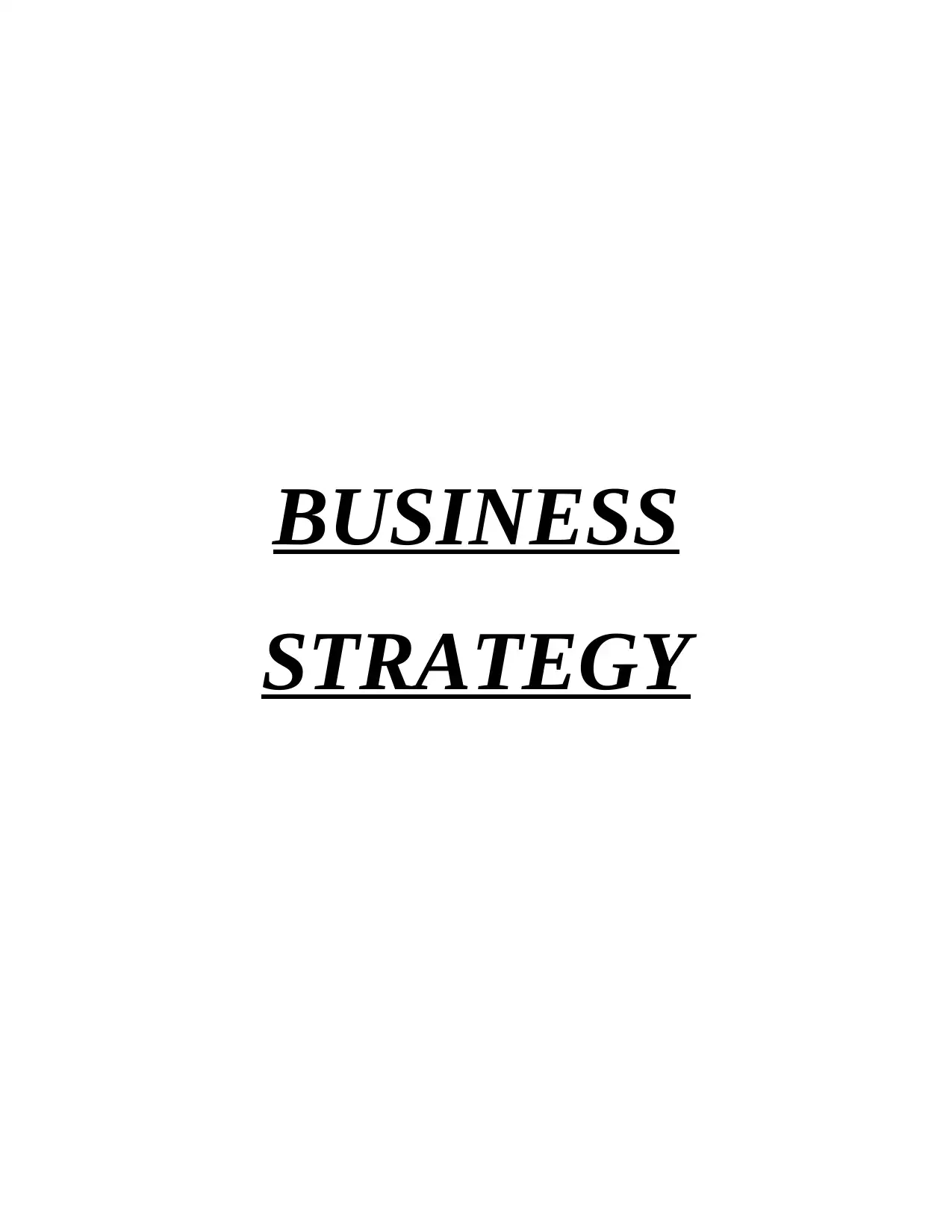
BUSINESS
STRATEGY
STRATEGY
Secure Best Marks with AI Grader
Need help grading? Try our AI Grader for instant feedback on your assignments.

Contents
INTRODUCTION...........................................................................................................................1
INTRODUCTION TO COMPANY................................................................................................1
P1. Analysis of impact and influence of macro environment on organisation and its strategies 3
P2. Internal environment and capabilities of a firm.....................................................................9
P3. Evaluation of competitive forces of retail industry.............................................................12
P4. Devising a strategic plan for company................................................................................15
CONCLUSION..............................................................................................................................18
REFERENCES..............................................................................................................................19
INTRODUCTION...........................................................................................................................1
INTRODUCTION TO COMPANY................................................................................................1
P1. Analysis of impact and influence of macro environment on organisation and its strategies 3
P2. Internal environment and capabilities of a firm.....................................................................9
P3. Evaluation of competitive forces of retail industry.............................................................12
P4. Devising a strategic plan for company................................................................................15
CONCLUSION..............................................................................................................................18
REFERENCES..............................................................................................................................19
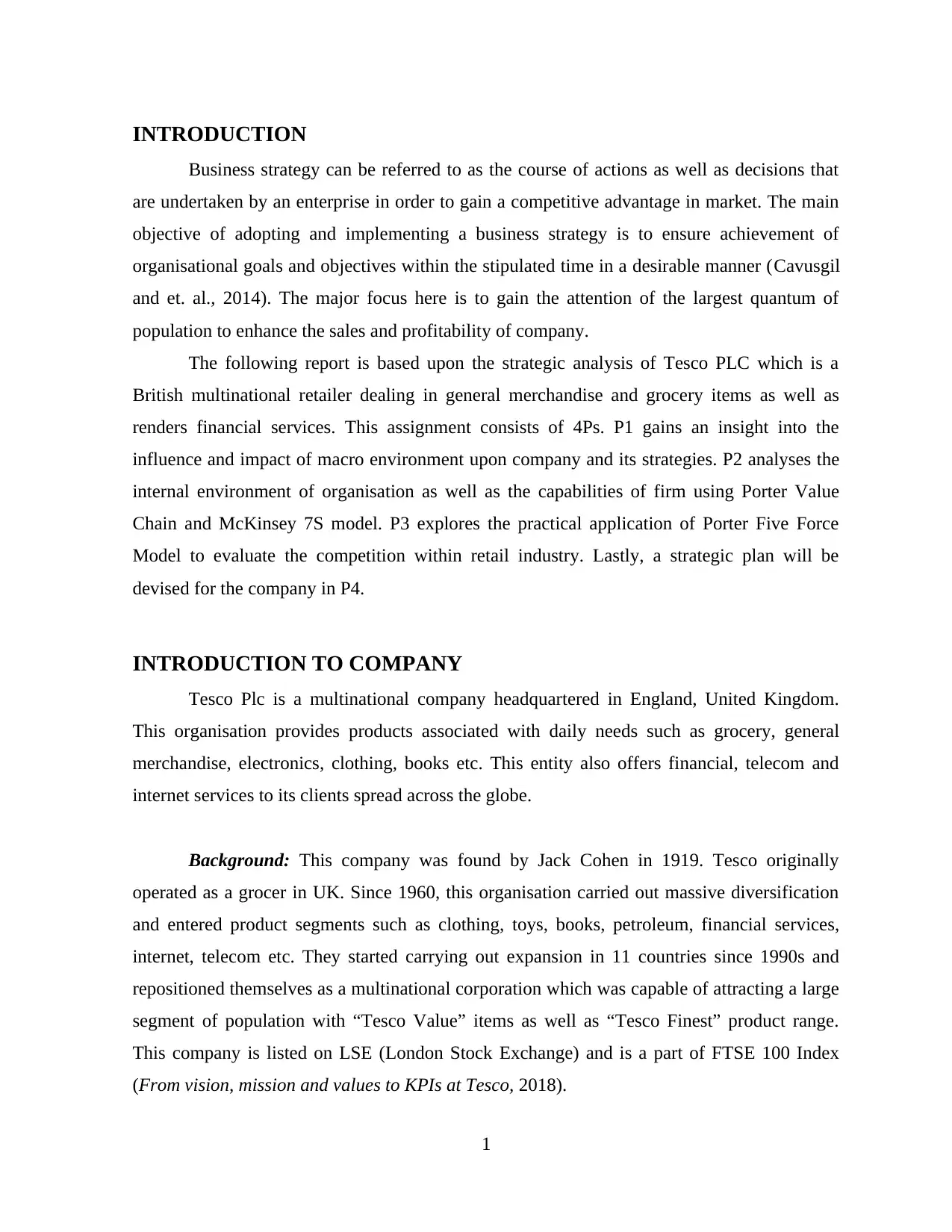
INTRODUCTION
Business strategy can be referred to as the course of actions as well as decisions that
are undertaken by an enterprise in order to gain a competitive advantage in market. The main
objective of adopting and implementing a business strategy is to ensure achievement of
organisational goals and objectives within the stipulated time in a desirable manner (Cavusgil
and et. al., 2014). The major focus here is to gain the attention of the largest quantum of
population to enhance the sales and profitability of company.
The following report is based upon the strategic analysis of Tesco PLC which is a
British multinational retailer dealing in general merchandise and grocery items as well as
renders financial services. This assignment consists of 4Ps. P1 gains an insight into the
influence and impact of macro environment upon company and its strategies. P2 analyses the
internal environment of organisation as well as the capabilities of firm using Porter Value
Chain and McKinsey 7S model. P3 explores the practical application of Porter Five Force
Model to evaluate the competition within retail industry. Lastly, a strategic plan will be
devised for the company in P4.
INTRODUCTION TO COMPANY
Tesco Plc is a multinational company headquartered in England, United Kingdom.
This organisation provides products associated with daily needs such as grocery, general
merchandise, electronics, clothing, books etc. This entity also offers financial, telecom and
internet services to its clients spread across the globe.
Background: This company was found by Jack Cohen in 1919. Tesco originally
operated as a grocer in UK. Since 1960, this organisation carried out massive diversification
and entered product segments such as clothing, toys, books, petroleum, financial services,
internet, telecom etc. They started carrying out expansion in 11 countries since 1990s and
repositioned themselves as a multinational corporation which was capable of attracting a large
segment of population with “Tesco Value” items as well as “Tesco Finest” product range.
This company is listed on LSE (London Stock Exchange) and is a part of FTSE 100 Index
(From vision, mission and values to KPIs at Tesco, 2018).
1
Business strategy can be referred to as the course of actions as well as decisions that
are undertaken by an enterprise in order to gain a competitive advantage in market. The main
objective of adopting and implementing a business strategy is to ensure achievement of
organisational goals and objectives within the stipulated time in a desirable manner (Cavusgil
and et. al., 2014). The major focus here is to gain the attention of the largest quantum of
population to enhance the sales and profitability of company.
The following report is based upon the strategic analysis of Tesco PLC which is a
British multinational retailer dealing in general merchandise and grocery items as well as
renders financial services. This assignment consists of 4Ps. P1 gains an insight into the
influence and impact of macro environment upon company and its strategies. P2 analyses the
internal environment of organisation as well as the capabilities of firm using Porter Value
Chain and McKinsey 7S model. P3 explores the practical application of Porter Five Force
Model to evaluate the competition within retail industry. Lastly, a strategic plan will be
devised for the company in P4.
INTRODUCTION TO COMPANY
Tesco Plc is a multinational company headquartered in England, United Kingdom.
This organisation provides products associated with daily needs such as grocery, general
merchandise, electronics, clothing, books etc. This entity also offers financial, telecom and
internet services to its clients spread across the globe.
Background: This company was found by Jack Cohen in 1919. Tesco originally
operated as a grocer in UK. Since 1960, this organisation carried out massive diversification
and entered product segments such as clothing, toys, books, petroleum, financial services,
internet, telecom etc. They started carrying out expansion in 11 countries since 1990s and
repositioned themselves as a multinational corporation which was capable of attracting a large
segment of population with “Tesco Value” items as well as “Tesco Finest” product range.
This company is listed on LSE (London Stock Exchange) and is a part of FTSE 100 Index
(From vision, mission and values to KPIs at Tesco, 2018).
1

Mission: The mission statement given by Tesco is “To make what matters the most to
people, together” (From vision, mission and values to KPIs at Tesco, 2018).
Vision: The vision statement given by Tesco is “To become the most valued company
in the eyes of customers, community and stakeholders”.
Objectives: The objectives of Tesco to ensure sustainability in market are given
below:-
To become a leading retailer within the global market.
To enhance the core business within UK to facilitate growth of operations in domestic
country.
To engage in social initiatives so as to act in the interest of community and
environment.
Sales and Profitability: This organisation is continuously growing over years owing to
its high quality products and its diversification strategy to gain a high stake in global
marketplace. The social, economic and marketing initiatives that are undertaken by this
organisation at regular intervals is the major reason behind this company being the third
largest retailer across the globe. As can be seen in the graph below, the profit earned by this
entity in last year (2018) was £1208m. This clearly indicates the edge of Tesco over rivals
within retail industry such as Marks & Spencer, ALDI, Sainsbury's, ASDA, LIDL etc. and the
capabilities that this organisation possess to continue to operate in the same manner in future
course of time.
2
people, together” (From vision, mission and values to KPIs at Tesco, 2018).
Vision: The vision statement given by Tesco is “To become the most valued company
in the eyes of customers, community and stakeholders”.
Objectives: The objectives of Tesco to ensure sustainability in market are given
below:-
To become a leading retailer within the global market.
To enhance the core business within UK to facilitate growth of operations in domestic
country.
To engage in social initiatives so as to act in the interest of community and
environment.
Sales and Profitability: This organisation is continuously growing over years owing to
its high quality products and its diversification strategy to gain a high stake in global
marketplace. The social, economic and marketing initiatives that are undertaken by this
organisation at regular intervals is the major reason behind this company being the third
largest retailer across the globe. As can be seen in the graph below, the profit earned by this
entity in last year (2018) was £1208m. This clearly indicates the edge of Tesco over rivals
within retail industry such as Marks & Spencer, ALDI, Sainsbury's, ASDA, LIDL etc. and the
capabilities that this organisation possess to continue to operate in the same manner in future
course of time.
2
Secure Best Marks with AI Grader
Need help grading? Try our AI Grader for instant feedback on your assignments.
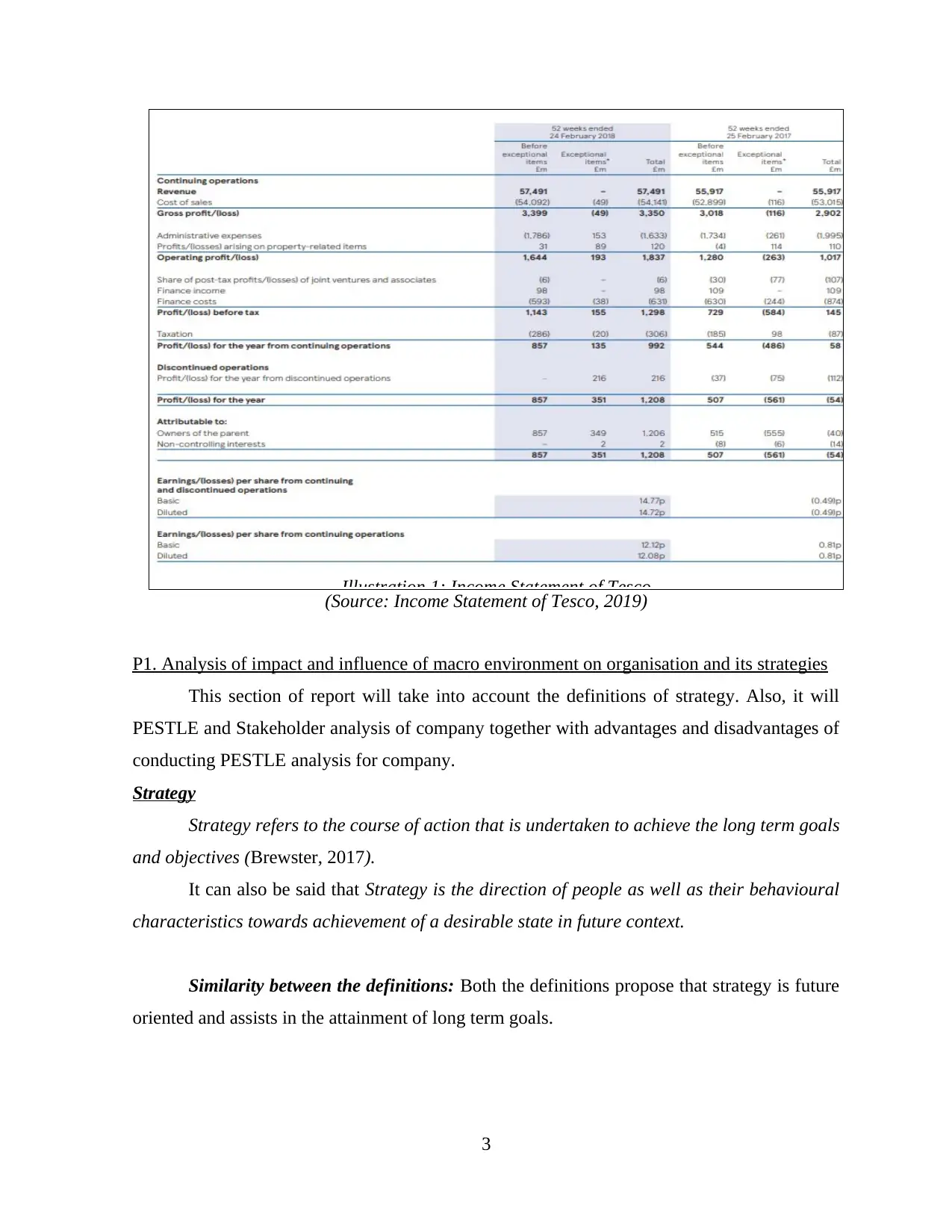
(Source: Income Statement of Tesco, 2019)
P1. Analysis of impact and influence of macro environment on organisation and its strategies
This section of report will take into account the definitions of strategy. Also, it will
PESTLE and Stakeholder analysis of company together with advantages and disadvantages of
conducting PESTLE analysis for company.
Strategy
Strategy refers to the course of action that is undertaken to achieve the long term goals
and objectives (Brewster, 2017).
It can also be said that Strategy is the direction of people as well as their behavioural
characteristics towards achievement of a desirable state in future context.
Similarity between the definitions: Both the definitions propose that strategy is future
oriented and assists in the attainment of long term goals.
3
Illustration 1: Income Statement of Tesco
P1. Analysis of impact and influence of macro environment on organisation and its strategies
This section of report will take into account the definitions of strategy. Also, it will
PESTLE and Stakeholder analysis of company together with advantages and disadvantages of
conducting PESTLE analysis for company.
Strategy
Strategy refers to the course of action that is undertaken to achieve the long term goals
and objectives (Brewster, 2017).
It can also be said that Strategy is the direction of people as well as their behavioural
characteristics towards achievement of a desirable state in future context.
Similarity between the definitions: Both the definitions propose that strategy is future
oriented and assists in the attainment of long term goals.
3
Illustration 1: Income Statement of Tesco
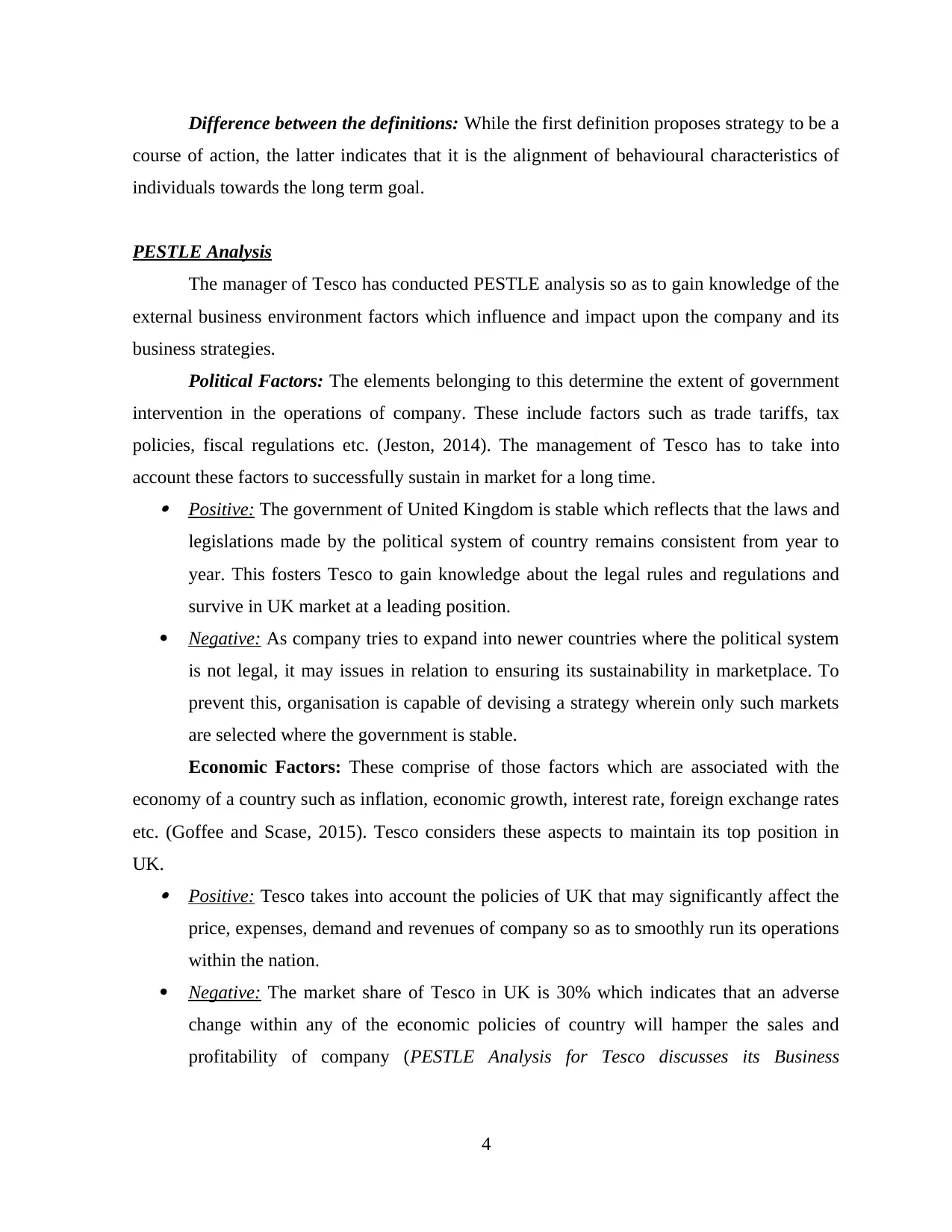
Difference between the definitions: While the first definition proposes strategy to be a
course of action, the latter indicates that it is the alignment of behavioural characteristics of
individuals towards the long term goal.
PESTLE Analysis
The manager of Tesco has conducted PESTLE analysis so as to gain knowledge of the
external business environment factors which influence and impact upon the company and its
business strategies.
Political Factors: The elements belonging to this determine the extent of government
intervention in the operations of company. These include factors such as trade tariffs, tax
policies, fiscal regulations etc. (Jeston, 2014). The management of Tesco has to take into
account these factors to successfully sustain in market for a long time.
Positive: The government of United Kingdom is stable which reflects that the laws and
legislations made by the political system of country remains consistent from year to
year. This fosters Tesco to gain knowledge about the legal rules and regulations and
survive in UK market at a leading position.
Negative: As company tries to expand into newer countries where the political system
is not legal, it may issues in relation to ensuring its sustainability in marketplace. To
prevent this, organisation is capable of devising a strategy wherein only such markets
are selected where the government is stable.
Economic Factors: These comprise of those factors which are associated with the
economy of a country such as inflation, economic growth, interest rate, foreign exchange rates
etc. (Goffee and Scase, 2015). Tesco considers these aspects to maintain its top position in
UK. Positive: Tesco takes into account the policies of UK that may significantly affect the
price, expenses, demand and revenues of company so as to smoothly run its operations
within the nation.
Negative: The market share of Tesco in UK is 30% which indicates that an adverse
change within any of the economic policies of country will hamper the sales and
profitability of company (PESTLE Analysis for Tesco discusses its Business
4
course of action, the latter indicates that it is the alignment of behavioural characteristics of
individuals towards the long term goal.
PESTLE Analysis
The manager of Tesco has conducted PESTLE analysis so as to gain knowledge of the
external business environment factors which influence and impact upon the company and its
business strategies.
Political Factors: The elements belonging to this determine the extent of government
intervention in the operations of company. These include factors such as trade tariffs, tax
policies, fiscal regulations etc. (Jeston, 2014). The management of Tesco has to take into
account these factors to successfully sustain in market for a long time.
Positive: The government of United Kingdom is stable which reflects that the laws and
legislations made by the political system of country remains consistent from year to
year. This fosters Tesco to gain knowledge about the legal rules and regulations and
survive in UK market at a leading position.
Negative: As company tries to expand into newer countries where the political system
is not legal, it may issues in relation to ensuring its sustainability in marketplace. To
prevent this, organisation is capable of devising a strategy wherein only such markets
are selected where the government is stable.
Economic Factors: These comprise of those factors which are associated with the
economy of a country such as inflation, economic growth, interest rate, foreign exchange rates
etc. (Goffee and Scase, 2015). Tesco considers these aspects to maintain its top position in
UK. Positive: Tesco takes into account the policies of UK that may significantly affect the
price, expenses, demand and revenues of company so as to smoothly run its operations
within the nation.
Negative: The market share of Tesco in UK is 30% which indicates that an adverse
change within any of the economic policies of country will hamper the sales and
profitability of company (PESTLE Analysis for Tesco discusses its Business
4
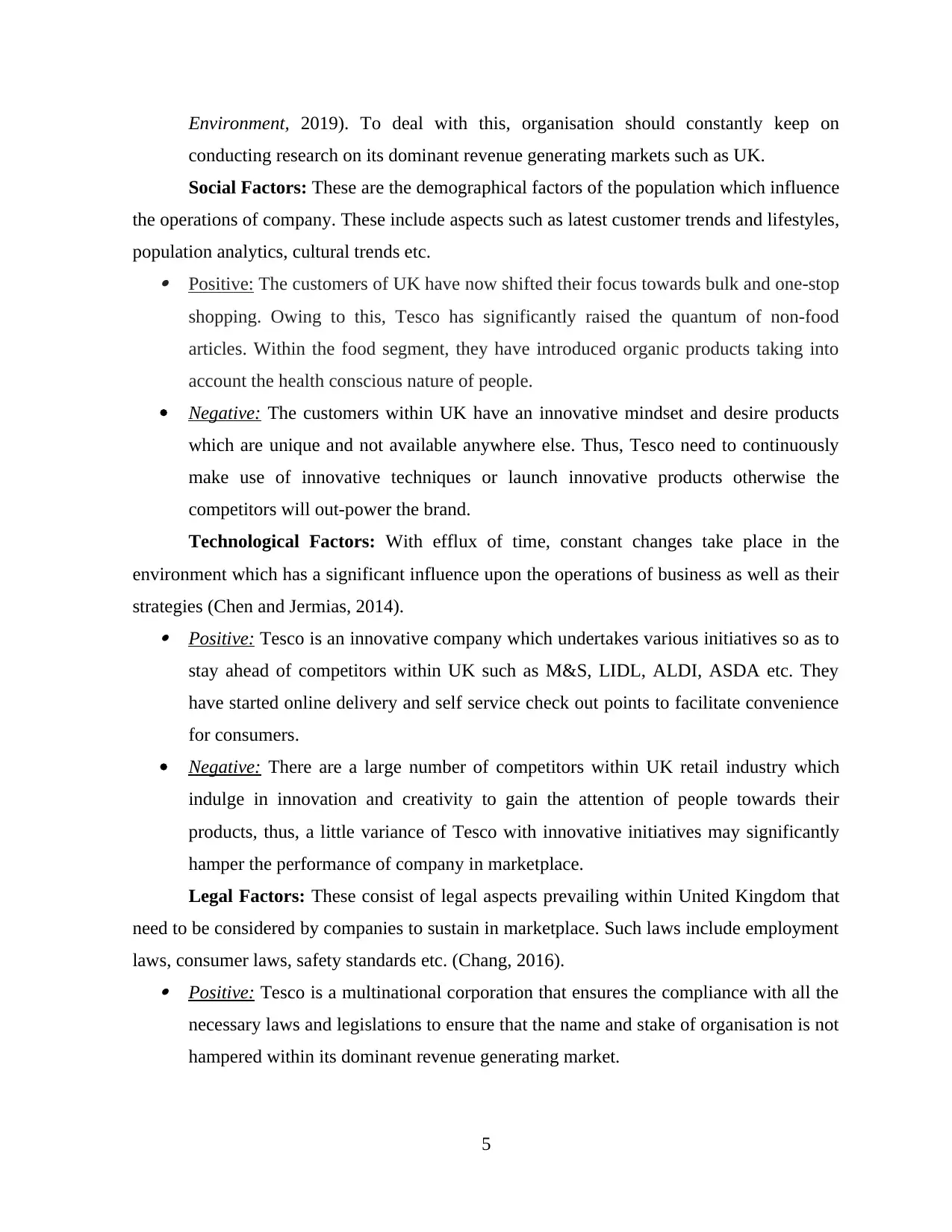
Environment, 2019). To deal with this, organisation should constantly keep on
conducting research on its dominant revenue generating markets such as UK.
Social Factors: These are the demographical factors of the population which influence
the operations of company. These include aspects such as latest customer trends and lifestyles,
population analytics, cultural trends etc.
Positive: The customers of UK have now shifted their focus towards bulk and one-stop
shopping. Owing to this, Tesco has significantly raised the quantum of non-food
articles. Within the food segment, they have introduced organic products taking into
account the health conscious nature of people.
Negative: The customers within UK have an innovative mindset and desire products
which are unique and not available anywhere else. Thus, Tesco need to continuously
make use of innovative techniques or launch innovative products otherwise the
competitors will out-power the brand.
Technological Factors: With efflux of time, constant changes take place in the
environment which has a significant influence upon the operations of business as well as their
strategies (Chen and Jermias, 2014).
Positive: Tesco is an innovative company which undertakes various initiatives so as to
stay ahead of competitors within UK such as M&S, LIDL, ALDI, ASDA etc. They
have started online delivery and self service check out points to facilitate convenience
for consumers.
Negative: There are a large number of competitors within UK retail industry which
indulge in innovation and creativity to gain the attention of people towards their
products, thus, a little variance of Tesco with innovative initiatives may significantly
hamper the performance of company in marketplace.
Legal Factors: These consist of legal aspects prevailing within United Kingdom that
need to be considered by companies to sustain in marketplace. Such laws include employment
laws, consumer laws, safety standards etc. (Chang, 2016).
Positive: Tesco is a multinational corporation that ensures the compliance with all the
necessary laws and legislations to ensure that the name and stake of organisation is not
hampered within its dominant revenue generating market.
5
conducting research on its dominant revenue generating markets such as UK.
Social Factors: These are the demographical factors of the population which influence
the operations of company. These include aspects such as latest customer trends and lifestyles,
population analytics, cultural trends etc.
Positive: The customers of UK have now shifted their focus towards bulk and one-stop
shopping. Owing to this, Tesco has significantly raised the quantum of non-food
articles. Within the food segment, they have introduced organic products taking into
account the health conscious nature of people.
Negative: The customers within UK have an innovative mindset and desire products
which are unique and not available anywhere else. Thus, Tesco need to continuously
make use of innovative techniques or launch innovative products otherwise the
competitors will out-power the brand.
Technological Factors: With efflux of time, constant changes take place in the
environment which has a significant influence upon the operations of business as well as their
strategies (Chen and Jermias, 2014).
Positive: Tesco is an innovative company which undertakes various initiatives so as to
stay ahead of competitors within UK such as M&S, LIDL, ALDI, ASDA etc. They
have started online delivery and self service check out points to facilitate convenience
for consumers.
Negative: There are a large number of competitors within UK retail industry which
indulge in innovation and creativity to gain the attention of people towards their
products, thus, a little variance of Tesco with innovative initiatives may significantly
hamper the performance of company in marketplace.
Legal Factors: These consist of legal aspects prevailing within United Kingdom that
need to be considered by companies to sustain in marketplace. Such laws include employment
laws, consumer laws, safety standards etc. (Chang, 2016).
Positive: Tesco is a multinational corporation that ensures the compliance with all the
necessary laws and legislations to ensure that the name and stake of organisation is not
hampered within its dominant revenue generating market.
5
Paraphrase This Document
Need a fresh take? Get an instant paraphrase of this document with our AI Paraphraser
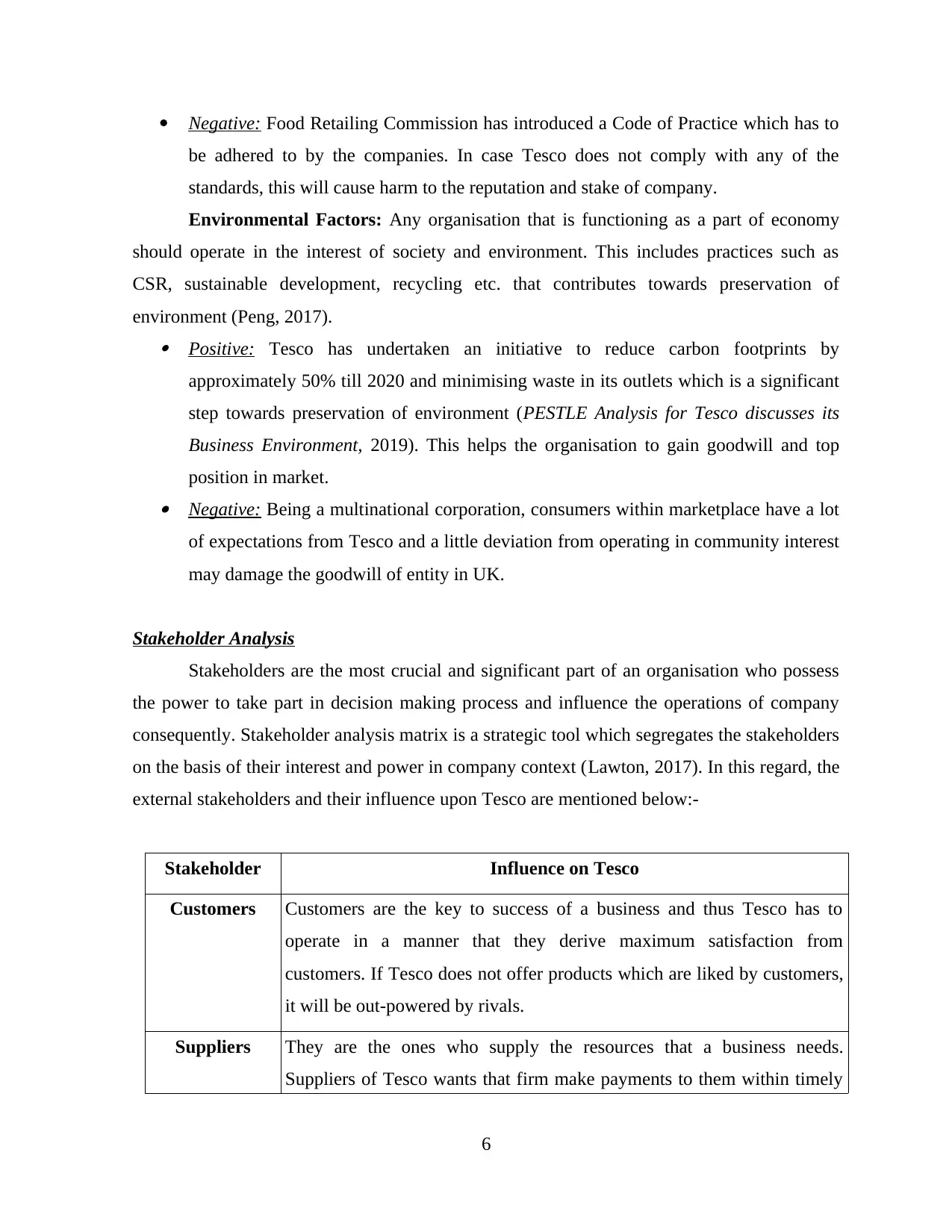
Negative: Food Retailing Commission has introduced a Code of Practice which has to
be adhered to by the companies. In case Tesco does not comply with any of the
standards, this will cause harm to the reputation and stake of company.
Environmental Factors: Any organisation that is functioning as a part of economy
should operate in the interest of society and environment. This includes practices such as
CSR, sustainable development, recycling etc. that contributes towards preservation of
environment (Peng, 2017).
Positive: Tesco has undertaken an initiative to reduce carbon footprints by
approximately 50% till 2020 and minimising waste in its outlets which is a significant
step towards preservation of environment (PESTLE Analysis for Tesco discusses its
Business Environment, 2019). This helps the organisation to gain goodwill and top
position in market.
Negative: Being a multinational corporation, consumers within marketplace have a lot
of expectations from Tesco and a little deviation from operating in community interest
may damage the goodwill of entity in UK.
Stakeholder Analysis
Stakeholders are the most crucial and significant part of an organisation who possess
the power to take part in decision making process and influence the operations of company
consequently. Stakeholder analysis matrix is a strategic tool which segregates the stakeholders
on the basis of their interest and power in company context (Lawton, 2017). In this regard, the
external stakeholders and their influence upon Tesco are mentioned below:-
Stakeholder Influence on Tesco
Customers Customers are the key to success of a business and thus Tesco has to
operate in a manner that they derive maximum satisfaction from
customers. If Tesco does not offer products which are liked by customers,
it will be out-powered by rivals.
Suppliers They are the ones who supply the resources that a business needs.
Suppliers of Tesco wants that firm make payments to them within timely
6
be adhered to by the companies. In case Tesco does not comply with any of the
standards, this will cause harm to the reputation and stake of company.
Environmental Factors: Any organisation that is functioning as a part of economy
should operate in the interest of society and environment. This includes practices such as
CSR, sustainable development, recycling etc. that contributes towards preservation of
environment (Peng, 2017).
Positive: Tesco has undertaken an initiative to reduce carbon footprints by
approximately 50% till 2020 and minimising waste in its outlets which is a significant
step towards preservation of environment (PESTLE Analysis for Tesco discusses its
Business Environment, 2019). This helps the organisation to gain goodwill and top
position in market.
Negative: Being a multinational corporation, consumers within marketplace have a lot
of expectations from Tesco and a little deviation from operating in community interest
may damage the goodwill of entity in UK.
Stakeholder Analysis
Stakeholders are the most crucial and significant part of an organisation who possess
the power to take part in decision making process and influence the operations of company
consequently. Stakeholder analysis matrix is a strategic tool which segregates the stakeholders
on the basis of their interest and power in company context (Lawton, 2017). In this regard, the
external stakeholders and their influence upon Tesco are mentioned below:-
Stakeholder Influence on Tesco
Customers Customers are the key to success of a business and thus Tesco has to
operate in a manner that they derive maximum satisfaction from
customers. If Tesco does not offer products which are liked by customers,
it will be out-powered by rivals.
Suppliers They are the ones who supply the resources that a business needs.
Suppliers of Tesco wants that firm make payments to them within timely
6
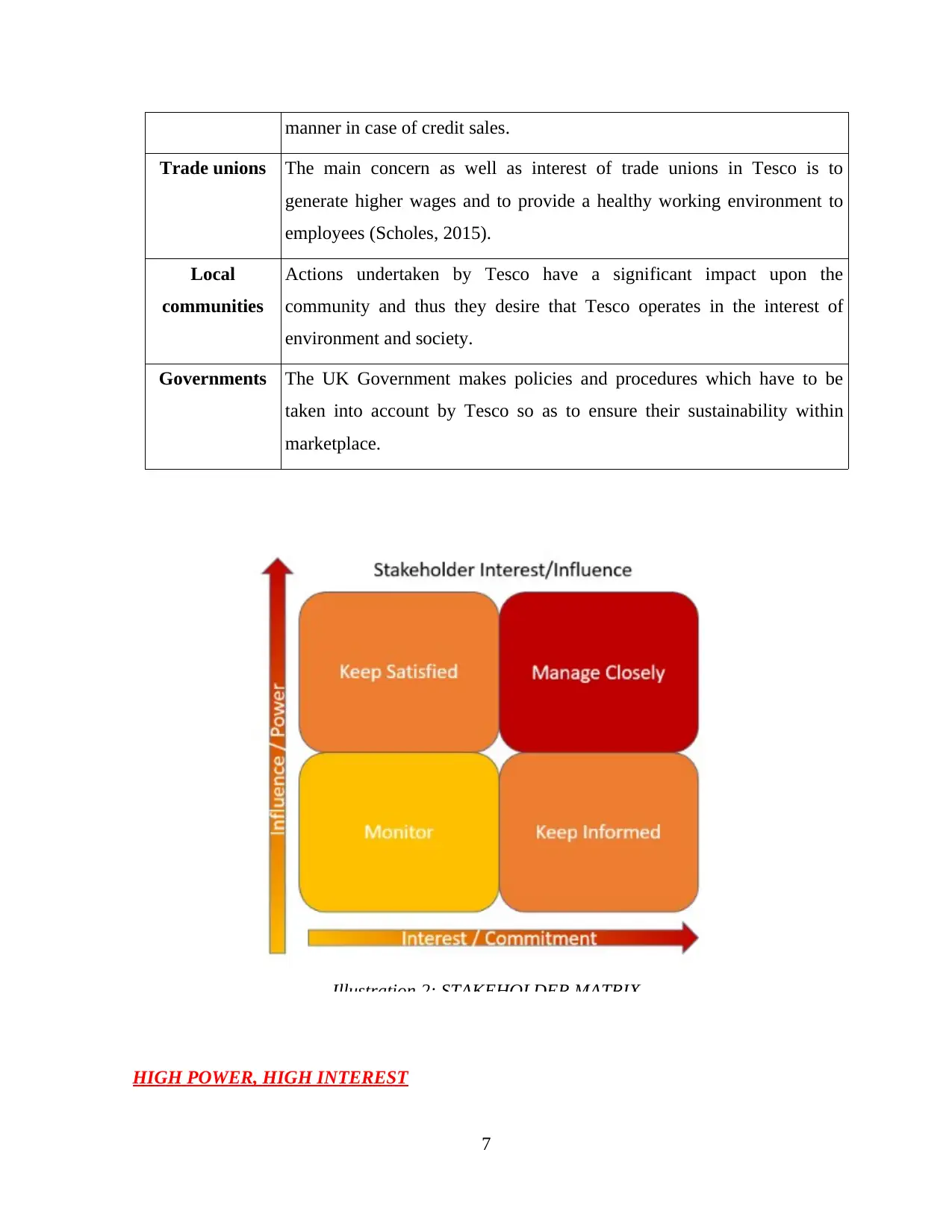
manner in case of credit sales.
Trade unions The main concern as well as interest of trade unions in Tesco is to
generate higher wages and to provide a healthy working environment to
employees (Scholes, 2015).
Local
communities
Actions undertaken by Tesco have a significant impact upon the
community and thus they desire that Tesco operates in the interest of
environment and society.
Governments The UK Government makes policies and procedures which have to be
taken into account by Tesco so as to ensure their sustainability within
marketplace.
HIGH POWER, HIGH INTEREST
7
Illustration 2: STAKEHOLDER MATRIX
Trade unions The main concern as well as interest of trade unions in Tesco is to
generate higher wages and to provide a healthy working environment to
employees (Scholes, 2015).
Local
communities
Actions undertaken by Tesco have a significant impact upon the
community and thus they desire that Tesco operates in the interest of
environment and society.
Governments The UK Government makes policies and procedures which have to be
taken into account by Tesco so as to ensure their sustainability within
marketplace.
HIGH POWER, HIGH INTEREST
7
Illustration 2: STAKEHOLDER MATRIX
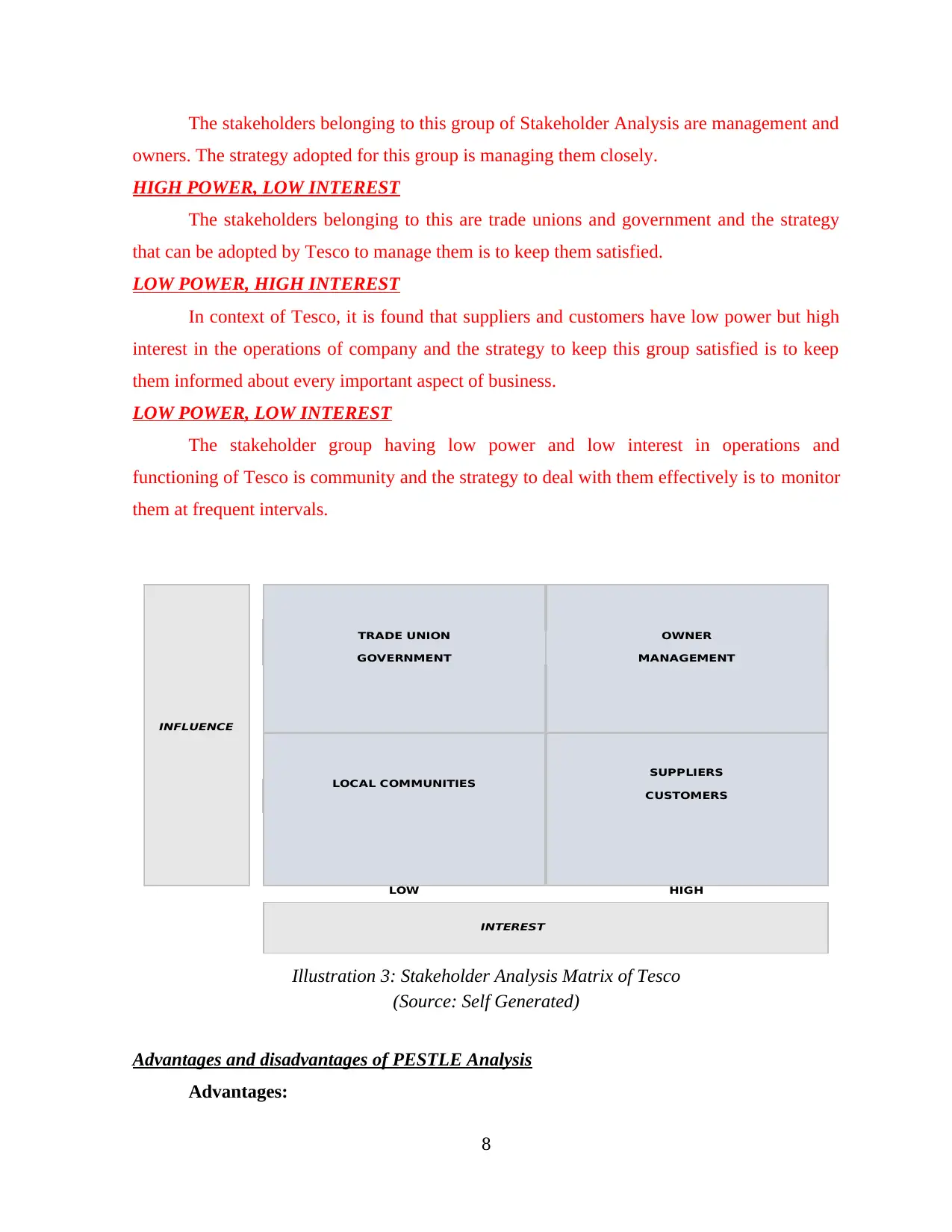
The stakeholders belonging to this group of Stakeholder Analysis are management and
owners. The strategy adopted for this group is managing them closely.
HIGH POWER, LOW INTEREST
The stakeholders belonging to this are trade unions and government and the strategy
that can be adopted by Tesco to manage them is to keep them satisfied.
LOW POWER, HIGH INTEREST
In context of Tesco, it is found that suppliers and customers have low power but high
interest in the operations of company and the strategy to keep this group satisfied is to keep
them informed about every important aspect of business.
LOW POWER, LOW INTEREST
The stakeholder group having low power and low interest in operations and
functioning of Tesco is community and the strategy to deal with them effectively is to monitor
them at frequent intervals.
(Source: Self Generated)
Advantages and disadvantages of PESTLE Analysis
Advantages:
8
TRADE UNION OWNER
GOVERNMENT MANAGEMENT
INFLUENCE
SUPPLIERS
LOCAL COMMUNITIES
CUSTOMERS
LOW HIGH
INTEREST
Illustration 3: Stakeholder Analysis Matrix of Tesco
owners. The strategy adopted for this group is managing them closely.
HIGH POWER, LOW INTEREST
The stakeholders belonging to this are trade unions and government and the strategy
that can be adopted by Tesco to manage them is to keep them satisfied.
LOW POWER, HIGH INTEREST
In context of Tesco, it is found that suppliers and customers have low power but high
interest in the operations of company and the strategy to keep this group satisfied is to keep
them informed about every important aspect of business.
LOW POWER, LOW INTEREST
The stakeholder group having low power and low interest in operations and
functioning of Tesco is community and the strategy to deal with them effectively is to monitor
them at frequent intervals.
(Source: Self Generated)
Advantages and disadvantages of PESTLE Analysis
Advantages:
8
TRADE UNION OWNER
GOVERNMENT MANAGEMENT
INFLUENCE
SUPPLIERS
LOCAL COMMUNITIES
CUSTOMERS
LOW HIGH
INTEREST
Illustration 3: Stakeholder Analysis Matrix of Tesco
Secure Best Marks with AI Grader
Need help grading? Try our AI Grader for instant feedback on your assignments.
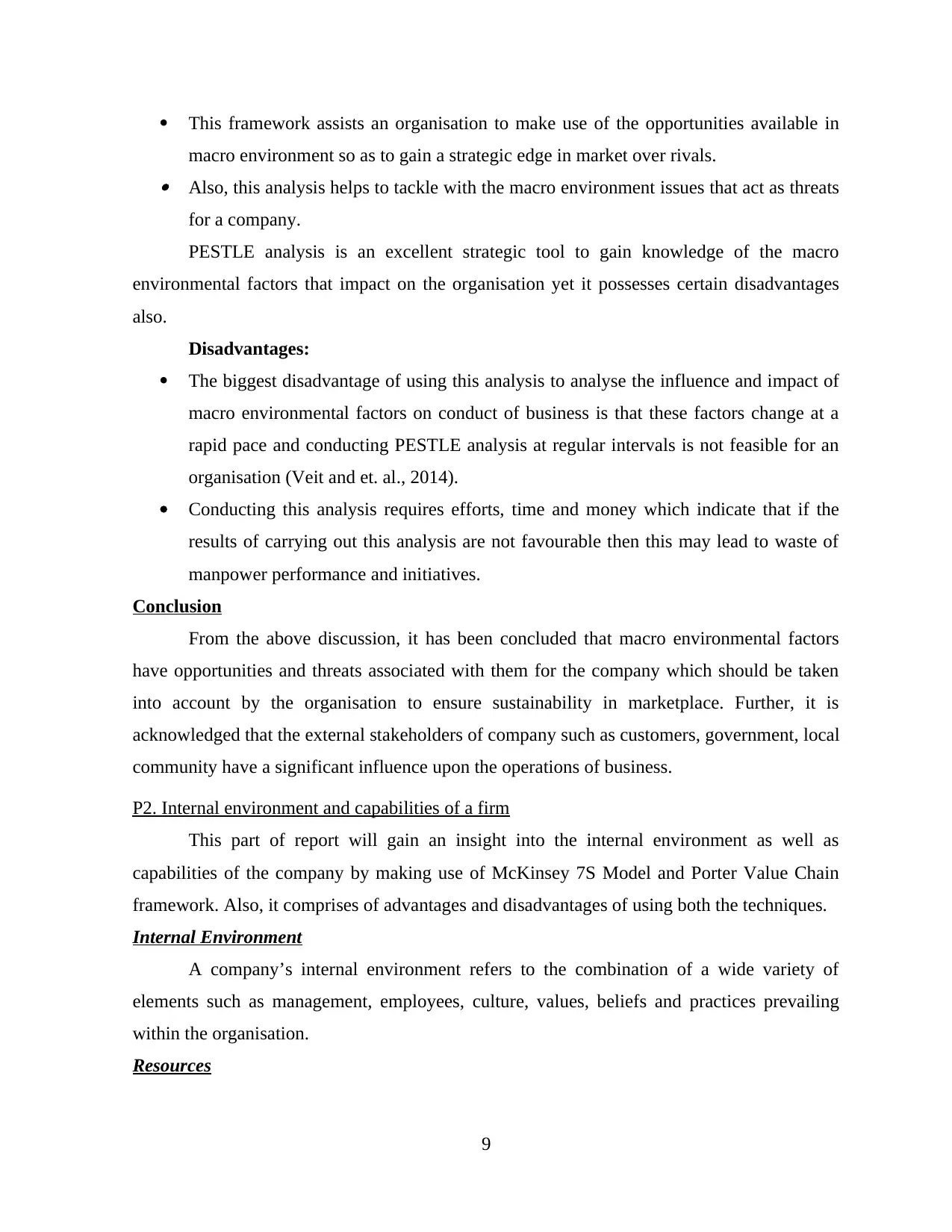
This framework assists an organisation to make use of the opportunities available in
macro environment so as to gain a strategic edge in market over rivals.
Also, this analysis helps to tackle with the macro environment issues that act as threats
for a company.
PESTLE analysis is an excellent strategic tool to gain knowledge of the macro
environmental factors that impact on the organisation yet it possesses certain disadvantages
also.
Disadvantages:
The biggest disadvantage of using this analysis to analyse the influence and impact of
macro environmental factors on conduct of business is that these factors change at a
rapid pace and conducting PESTLE analysis at regular intervals is not feasible for an
organisation (Veit and et. al., 2014).
Conducting this analysis requires efforts, time and money which indicate that if the
results of carrying out this analysis are not favourable then this may lead to waste of
manpower performance and initiatives.
Conclusion
From the above discussion, it has been concluded that macro environmental factors
have opportunities and threats associated with them for the company which should be taken
into account by the organisation to ensure sustainability in marketplace. Further, it is
acknowledged that the external stakeholders of company such as customers, government, local
community have a significant influence upon the operations of business.
P2. Internal environment and capabilities of a firm
This part of report will gain an insight into the internal environment as well as
capabilities of the company by making use of McKinsey 7S Model and Porter Value Chain
framework. Also, it comprises of advantages and disadvantages of using both the techniques.
Internal Environment
A company’s internal environment refers to the combination of a wide variety of
elements such as management, employees, culture, values, beliefs and practices prevailing
within the organisation.
Resources
9
macro environment so as to gain a strategic edge in market over rivals.
Also, this analysis helps to tackle with the macro environment issues that act as threats
for a company.
PESTLE analysis is an excellent strategic tool to gain knowledge of the macro
environmental factors that impact on the organisation yet it possesses certain disadvantages
also.
Disadvantages:
The biggest disadvantage of using this analysis to analyse the influence and impact of
macro environmental factors on conduct of business is that these factors change at a
rapid pace and conducting PESTLE analysis at regular intervals is not feasible for an
organisation (Veit and et. al., 2014).
Conducting this analysis requires efforts, time and money which indicate that if the
results of carrying out this analysis are not favourable then this may lead to waste of
manpower performance and initiatives.
Conclusion
From the above discussion, it has been concluded that macro environmental factors
have opportunities and threats associated with them for the company which should be taken
into account by the organisation to ensure sustainability in marketplace. Further, it is
acknowledged that the external stakeholders of company such as customers, government, local
community have a significant influence upon the operations of business.
P2. Internal environment and capabilities of a firm
This part of report will gain an insight into the internal environment as well as
capabilities of the company by making use of McKinsey 7S Model and Porter Value Chain
framework. Also, it comprises of advantages and disadvantages of using both the techniques.
Internal Environment
A company’s internal environment refers to the combination of a wide variety of
elements such as management, employees, culture, values, beliefs and practices prevailing
within the organisation.
Resources
9
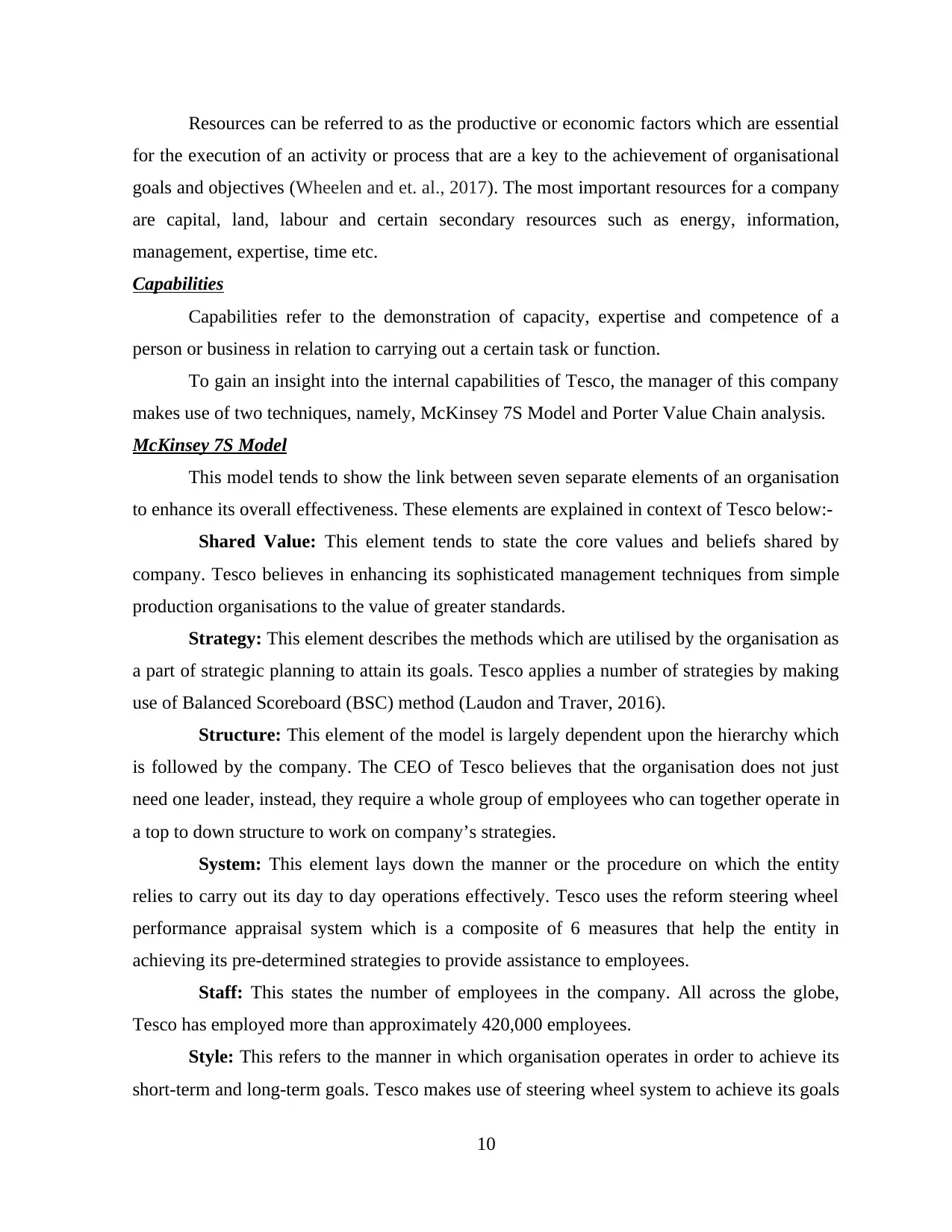
Resources can be referred to as the productive or economic factors which are essential
for the execution of an activity or process that are a key to the achievement of organisational
goals and objectives (Wheelen and et. al., 2017). The most important resources for a company
are capital, land, labour and certain secondary resources such as energy, information,
management, expertise, time etc.
Capabilities
Capabilities refer to the demonstration of capacity, expertise and competence of a
person or business in relation to carrying out a certain task or function.
To gain an insight into the internal capabilities of Tesco, the manager of this company
makes use of two techniques, namely, McKinsey 7S Model and Porter Value Chain analysis.
McKinsey 7S Model
This model tends to show the link between seven separate elements of an organisation
to enhance its overall effectiveness. These elements are explained in context of Tesco below:-
Shared Value: This element tends to state the core values and beliefs shared by
company. Tesco believes in enhancing its sophisticated management techniques from simple
production organisations to the value of greater standards.
Strategy: This element describes the methods which are utilised by the organisation as
a part of strategic planning to attain its goals. Tesco applies a number of strategies by making
use of Balanced Scoreboard (BSC) method (Laudon and Traver, 2016).
Structure: This element of the model is largely dependent upon the hierarchy which
is followed by the company. The CEO of Tesco believes that the organisation does not just
need one leader, instead, they require a whole group of employees who can together operate in
a top to down structure to work on company’s strategies.
System: This element lays down the manner or the procedure on which the entity
relies to carry out its day to day operations effectively. Tesco uses the reform steering wheel
performance appraisal system which is a composite of 6 measures that help the entity in
achieving its pre-determined strategies to provide assistance to employees.
Staff: This states the number of employees in the company. All across the globe,
Tesco has employed more than approximately 420,000 employees.
Style: This refers to the manner in which organisation operates in order to achieve its
short-term and long-term goals. Tesco makes use of steering wheel system to achieve its goals
10
for the execution of an activity or process that are a key to the achievement of organisational
goals and objectives (Wheelen and et. al., 2017). The most important resources for a company
are capital, land, labour and certain secondary resources such as energy, information,
management, expertise, time etc.
Capabilities
Capabilities refer to the demonstration of capacity, expertise and competence of a
person or business in relation to carrying out a certain task or function.
To gain an insight into the internal capabilities of Tesco, the manager of this company
makes use of two techniques, namely, McKinsey 7S Model and Porter Value Chain analysis.
McKinsey 7S Model
This model tends to show the link between seven separate elements of an organisation
to enhance its overall effectiveness. These elements are explained in context of Tesco below:-
Shared Value: This element tends to state the core values and beliefs shared by
company. Tesco believes in enhancing its sophisticated management techniques from simple
production organisations to the value of greater standards.
Strategy: This element describes the methods which are utilised by the organisation as
a part of strategic planning to attain its goals. Tesco applies a number of strategies by making
use of Balanced Scoreboard (BSC) method (Laudon and Traver, 2016).
Structure: This element of the model is largely dependent upon the hierarchy which
is followed by the company. The CEO of Tesco believes that the organisation does not just
need one leader, instead, they require a whole group of employees who can together operate in
a top to down structure to work on company’s strategies.
System: This element lays down the manner or the procedure on which the entity
relies to carry out its day to day operations effectively. Tesco uses the reform steering wheel
performance appraisal system which is a composite of 6 measures that help the entity in
achieving its pre-determined strategies to provide assistance to employees.
Staff: This states the number of employees in the company. All across the globe,
Tesco has employed more than approximately 420,000 employees.
Style: This refers to the manner in which organisation operates in order to achieve its
short-term and long-term goals. Tesco makes use of steering wheel system to achieve its goals
10
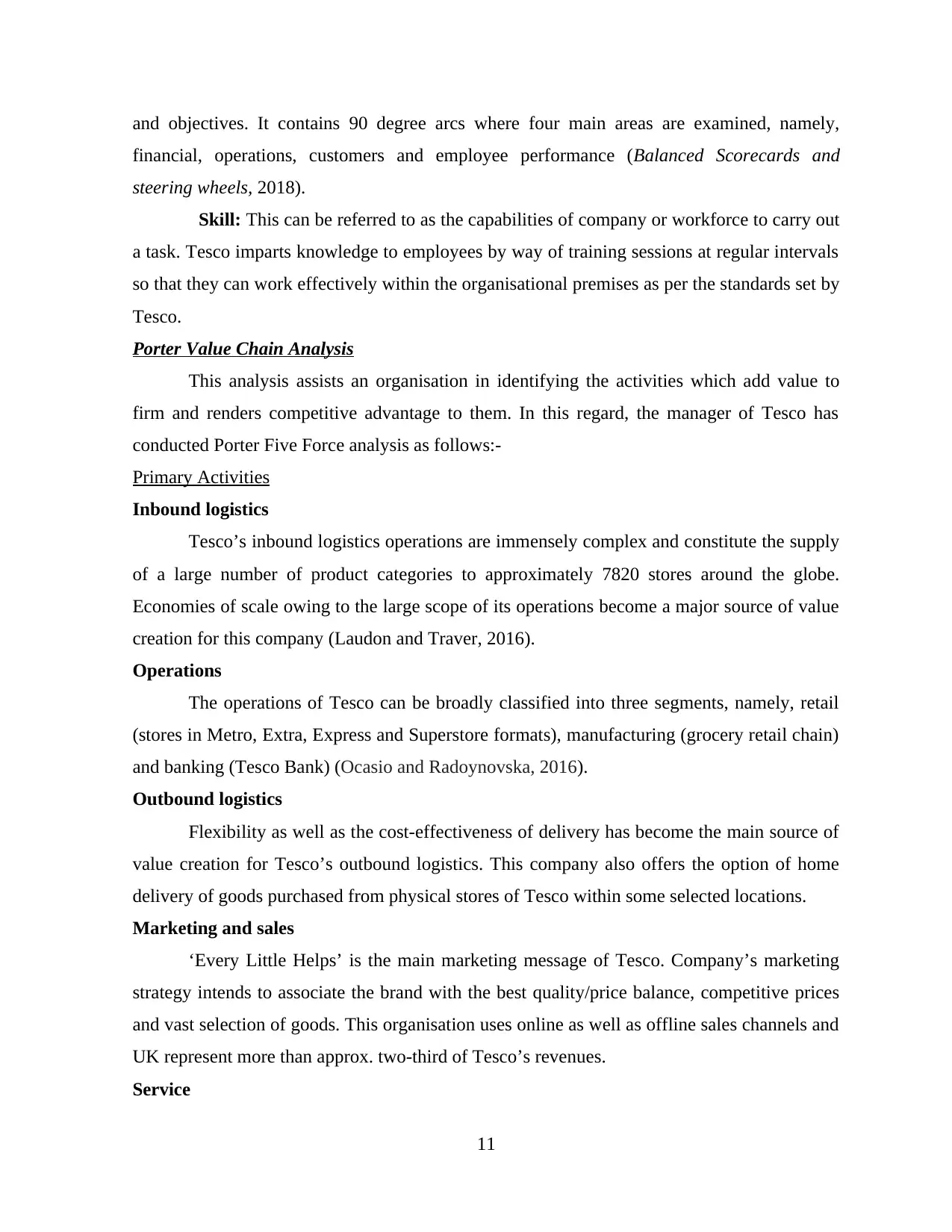
and objectives. It contains 90 degree arcs where four main areas are examined, namely,
financial, operations, customers and employee performance (Balanced Scorecards and
steering wheels, 2018).
Skill: This can be referred to as the capabilities of company or workforce to carry out
a task. Tesco imparts knowledge to employees by way of training sessions at regular intervals
so that they can work effectively within the organisational premises as per the standards set by
Tesco.
Porter Value Chain Analysis
This analysis assists an organisation in identifying the activities which add value to
firm and renders competitive advantage to them. In this regard, the manager of Tesco has
conducted Porter Five Force analysis as follows:-
Primary Activities
Inbound logistics
Tesco’s inbound logistics operations are immensely complex and constitute the supply
of a large number of product categories to approximately 7820 stores around the globe.
Economies of scale owing to the large scope of its operations become a major source of value
creation for this company (Laudon and Traver, 2016).
Operations
The operations of Tesco can be broadly classified into three segments, namely, retail
(stores in Metro, Extra, Express and Superstore formats), manufacturing (grocery retail chain)
and banking (Tesco Bank) (Ocasio and Radoynovska, 2016).
Outbound logistics
Flexibility as well as the cost-effectiveness of delivery has become the main source of
value creation for Tesco’s outbound logistics. This company also offers the option of home
delivery of goods purchased from physical stores of Tesco within some selected locations.
Marketing and sales
‘Every Little Helps’ is the main marketing message of Tesco. Company’s marketing
strategy intends to associate the brand with the best quality/price balance, competitive prices
and vast selection of goods. This organisation uses online as well as offline sales channels and
UK represent more than approx. two-third of Tesco’s revenues.
Service
11
financial, operations, customers and employee performance (Balanced Scorecards and
steering wheels, 2018).
Skill: This can be referred to as the capabilities of company or workforce to carry out
a task. Tesco imparts knowledge to employees by way of training sessions at regular intervals
so that they can work effectively within the organisational premises as per the standards set by
Tesco.
Porter Value Chain Analysis
This analysis assists an organisation in identifying the activities which add value to
firm and renders competitive advantage to them. In this regard, the manager of Tesco has
conducted Porter Five Force analysis as follows:-
Primary Activities
Inbound logistics
Tesco’s inbound logistics operations are immensely complex and constitute the supply
of a large number of product categories to approximately 7820 stores around the globe.
Economies of scale owing to the large scope of its operations become a major source of value
creation for this company (Laudon and Traver, 2016).
Operations
The operations of Tesco can be broadly classified into three segments, namely, retail
(stores in Metro, Extra, Express and Superstore formats), manufacturing (grocery retail chain)
and banking (Tesco Bank) (Ocasio and Radoynovska, 2016).
Outbound logistics
Flexibility as well as the cost-effectiveness of delivery has become the main source of
value creation for Tesco’s outbound logistics. This company also offers the option of home
delivery of goods purchased from physical stores of Tesco within some selected locations.
Marketing and sales
‘Every Little Helps’ is the main marketing message of Tesco. Company’s marketing
strategy intends to associate the brand with the best quality/price balance, competitive prices
and vast selection of goods. This organisation uses online as well as offline sales channels and
UK represent more than approx. two-third of Tesco’s revenues.
Service
11
Paraphrase This Document
Need a fresh take? Get an instant paraphrase of this document with our AI Paraphraser
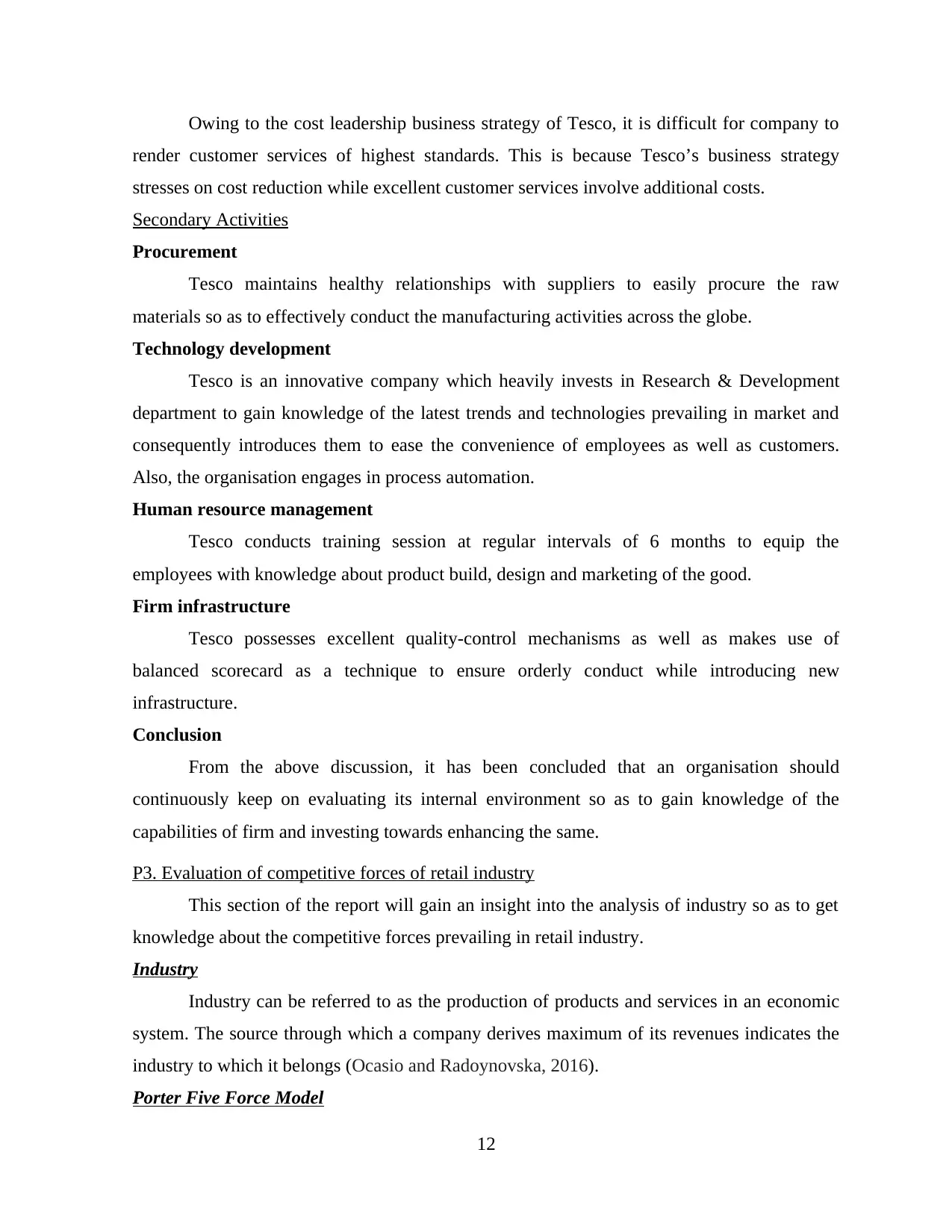
Owing to the cost leadership business strategy of Tesco, it is difficult for company to
render customer services of highest standards. This is because Tesco’s business strategy
stresses on cost reduction while excellent customer services involve additional costs.
Secondary Activities
Procurement
Tesco maintains healthy relationships with suppliers to easily procure the raw
materials so as to effectively conduct the manufacturing activities across the globe.
Technology development
Tesco is an innovative company which heavily invests in Research & Development
department to gain knowledge of the latest trends and technologies prevailing in market and
consequently introduces them to ease the convenience of employees as well as customers.
Also, the organisation engages in process automation.
Human resource management
Tesco conducts training session at regular intervals of 6 months to equip the
employees with knowledge about product build, design and marketing of the good.
Firm infrastructure
Tesco possesses excellent quality-control mechanisms as well as makes use of
balanced scorecard as a technique to ensure orderly conduct while introducing new
infrastructure.
Conclusion
From the above discussion, it has been concluded that an organisation should
continuously keep on evaluating its internal environment so as to gain knowledge of the
capabilities of firm and investing towards enhancing the same.
P3. Evaluation of competitive forces of retail industry
This section of the report will gain an insight into the analysis of industry so as to get
knowledge about the competitive forces prevailing in retail industry.
Industry
Industry can be referred to as the production of products and services in an economic
system. The source through which a company derives maximum of its revenues indicates the
industry to which it belongs (Ocasio and Radoynovska, 2016).
Porter Five Force Model
12
render customer services of highest standards. This is because Tesco’s business strategy
stresses on cost reduction while excellent customer services involve additional costs.
Secondary Activities
Procurement
Tesco maintains healthy relationships with suppliers to easily procure the raw
materials so as to effectively conduct the manufacturing activities across the globe.
Technology development
Tesco is an innovative company which heavily invests in Research & Development
department to gain knowledge of the latest trends and technologies prevailing in market and
consequently introduces them to ease the convenience of employees as well as customers.
Also, the organisation engages in process automation.
Human resource management
Tesco conducts training session at regular intervals of 6 months to equip the
employees with knowledge about product build, design and marketing of the good.
Firm infrastructure
Tesco possesses excellent quality-control mechanisms as well as makes use of
balanced scorecard as a technique to ensure orderly conduct while introducing new
infrastructure.
Conclusion
From the above discussion, it has been concluded that an organisation should
continuously keep on evaluating its internal environment so as to gain knowledge of the
capabilities of firm and investing towards enhancing the same.
P3. Evaluation of competitive forces of retail industry
This section of the report will gain an insight into the analysis of industry so as to get
knowledge about the competitive forces prevailing in retail industry.
Industry
Industry can be referred to as the production of products and services in an economic
system. The source through which a company derives maximum of its revenues indicates the
industry to which it belongs (Ocasio and Radoynovska, 2016).
Porter Five Force Model
12
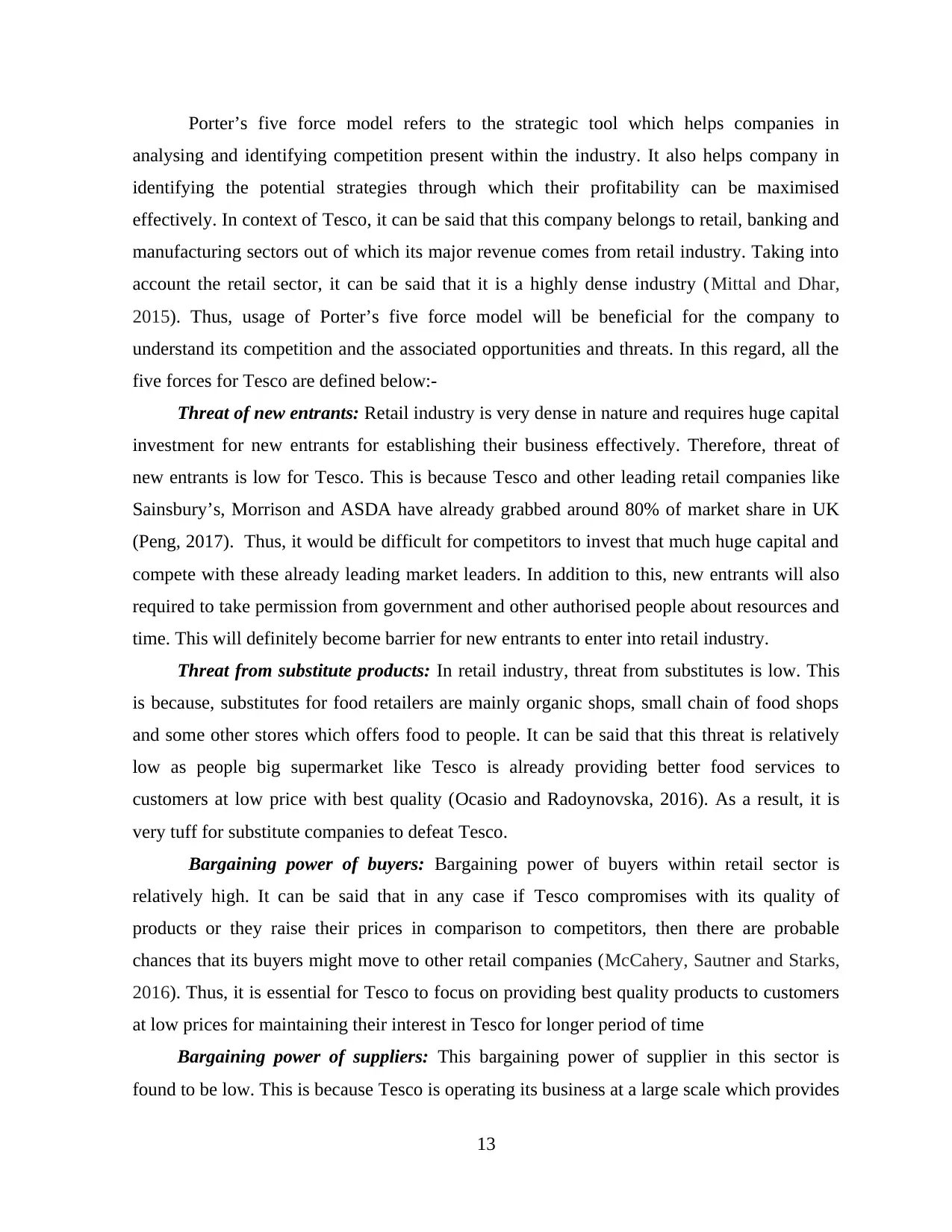
Porter’s five force model refers to the strategic tool which helps companies in
analysing and identifying competition present within the industry. It also helps company in
identifying the potential strategies through which their profitability can be maximised
effectively. In context of Tesco, it can be said that this company belongs to retail, banking and
manufacturing sectors out of which its major revenue comes from retail industry. Taking into
account the retail sector, it can be said that it is a highly dense industry (Mittal and Dhar,
2015). Thus, usage of Porter’s five force model will be beneficial for the company to
understand its competition and the associated opportunities and threats. In this regard, all the
five forces for Tesco are defined below:-
Threat of new entrants: Retail industry is very dense in nature and requires huge capital
investment for new entrants for establishing their business effectively. Therefore, threat of
new entrants is low for Tesco. This is because Tesco and other leading retail companies like
Sainsbury’s, Morrison and ASDA have already grabbed around 80% of market share in UK
(Peng, 2017). Thus, it would be difficult for competitors to invest that much huge capital and
compete with these already leading market leaders. In addition to this, new entrants will also
required to take permission from government and other authorised people about resources and
time. This will definitely become barrier for new entrants to enter into retail industry.
Threat from substitute products: In retail industry, threat from substitutes is low. This
is because, substitutes for food retailers are mainly organic shops, small chain of food shops
and some other stores which offers food to people. It can be said that this threat is relatively
low as people big supermarket like Tesco is already providing better food services to
customers at low price with best quality (Ocasio and Radoynovska, 2016). As a result, it is
very tuff for substitute companies to defeat Tesco.
Bargaining power of buyers: Bargaining power of buyers within retail sector is
relatively high. It can be said that in any case if Tesco compromises with its quality of
products or they raise their prices in comparison to competitors, then there are probable
chances that its buyers might move to other retail companies (McCahery, Sautner and Starks,
2016). Thus, it is essential for Tesco to focus on providing best quality products to customers
at low prices for maintaining their interest in Tesco for longer period of time
Bargaining power of suppliers: This bargaining power of supplier in this sector is
found to be low. This is because Tesco is operating its business at a large scale which provides
13
analysing and identifying competition present within the industry. It also helps company in
identifying the potential strategies through which their profitability can be maximised
effectively. In context of Tesco, it can be said that this company belongs to retail, banking and
manufacturing sectors out of which its major revenue comes from retail industry. Taking into
account the retail sector, it can be said that it is a highly dense industry (Mittal and Dhar,
2015). Thus, usage of Porter’s five force model will be beneficial for the company to
understand its competition and the associated opportunities and threats. In this regard, all the
five forces for Tesco are defined below:-
Threat of new entrants: Retail industry is very dense in nature and requires huge capital
investment for new entrants for establishing their business effectively. Therefore, threat of
new entrants is low for Tesco. This is because Tesco and other leading retail companies like
Sainsbury’s, Morrison and ASDA have already grabbed around 80% of market share in UK
(Peng, 2017). Thus, it would be difficult for competitors to invest that much huge capital and
compete with these already leading market leaders. In addition to this, new entrants will also
required to take permission from government and other authorised people about resources and
time. This will definitely become barrier for new entrants to enter into retail industry.
Threat from substitute products: In retail industry, threat from substitutes is low. This
is because, substitutes for food retailers are mainly organic shops, small chain of food shops
and some other stores which offers food to people. It can be said that this threat is relatively
low as people big supermarket like Tesco is already providing better food services to
customers at low price with best quality (Ocasio and Radoynovska, 2016). As a result, it is
very tuff for substitute companies to defeat Tesco.
Bargaining power of buyers: Bargaining power of buyers within retail sector is
relatively high. It can be said that in any case if Tesco compromises with its quality of
products or they raise their prices in comparison to competitors, then there are probable
chances that its buyers might move to other retail companies (McCahery, Sautner and Starks,
2016). Thus, it is essential for Tesco to focus on providing best quality products to customers
at low prices for maintaining their interest in Tesco for longer period of time
Bargaining power of suppliers: This bargaining power of supplier in this sector is
found to be low. This is because Tesco is operating its business at a large scale which provides
13
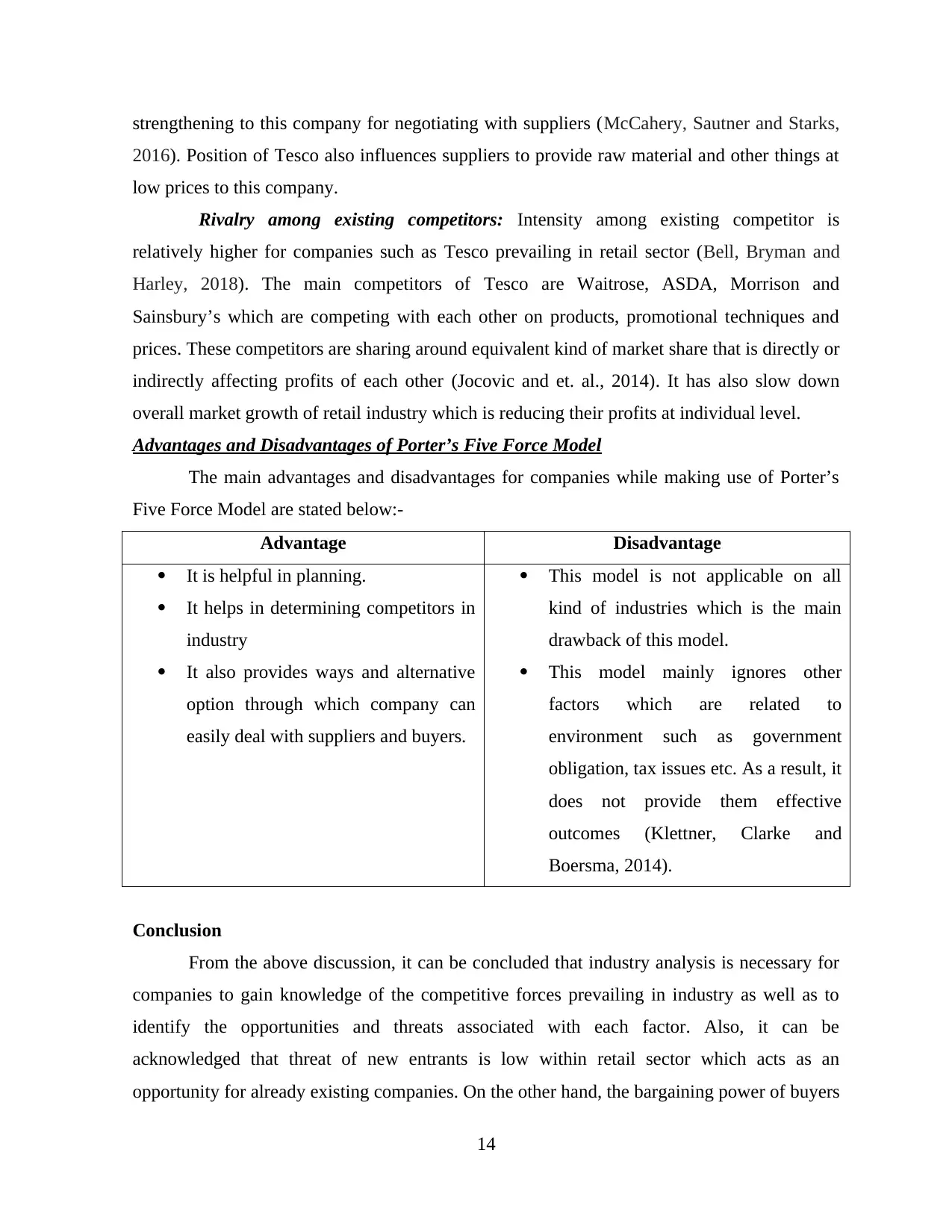
strengthening to this company for negotiating with suppliers (McCahery, Sautner and Starks,
2016). Position of Tesco also influences suppliers to provide raw material and other things at
low prices to this company.
Rivalry among existing competitors: Intensity among existing competitor is
relatively higher for companies such as Tesco prevailing in retail sector (Bell, Bryman and
Harley, 2018). The main competitors of Tesco are Waitrose, ASDA, Morrison and
Sainsbury’s which are competing with each other on products, promotional techniques and
prices. These competitors are sharing around equivalent kind of market share that is directly or
indirectly affecting profits of each other (Jocovic and et. al., 2014). It has also slow down
overall market growth of retail industry which is reducing their profits at individual level.
Advantages and Disadvantages of Porter’s Five Force Model
The main advantages and disadvantages for companies while making use of Porter’s
Five Force Model are stated below:-
Advantage Disadvantage
It is helpful in planning.
It helps in determining competitors in
industry
It also provides ways and alternative
option through which company can
easily deal with suppliers and buyers.
This model is not applicable on all
kind of industries which is the main
drawback of this model.
This model mainly ignores other
factors which are related to
environment such as government
obligation, tax issues etc. As a result, it
does not provide them effective
outcomes (Klettner, Clarke and
Boersma, 2014).
Conclusion
From the above discussion, it can be concluded that industry analysis is necessary for
companies to gain knowledge of the competitive forces prevailing in industry as well as to
identify the opportunities and threats associated with each factor. Also, it can be
acknowledged that threat of new entrants is low within retail sector which acts as an
opportunity for already existing companies. On the other hand, the bargaining power of buyers
14
2016). Position of Tesco also influences suppliers to provide raw material and other things at
low prices to this company.
Rivalry among existing competitors: Intensity among existing competitor is
relatively higher for companies such as Tesco prevailing in retail sector (Bell, Bryman and
Harley, 2018). The main competitors of Tesco are Waitrose, ASDA, Morrison and
Sainsbury’s which are competing with each other on products, promotional techniques and
prices. These competitors are sharing around equivalent kind of market share that is directly or
indirectly affecting profits of each other (Jocovic and et. al., 2014). It has also slow down
overall market growth of retail industry which is reducing their profits at individual level.
Advantages and Disadvantages of Porter’s Five Force Model
The main advantages and disadvantages for companies while making use of Porter’s
Five Force Model are stated below:-
Advantage Disadvantage
It is helpful in planning.
It helps in determining competitors in
industry
It also provides ways and alternative
option through which company can
easily deal with suppliers and buyers.
This model is not applicable on all
kind of industries which is the main
drawback of this model.
This model mainly ignores other
factors which are related to
environment such as government
obligation, tax issues etc. As a result, it
does not provide them effective
outcomes (Klettner, Clarke and
Boersma, 2014).
Conclusion
From the above discussion, it can be concluded that industry analysis is necessary for
companies to gain knowledge of the competitive forces prevailing in industry as well as to
identify the opportunities and threats associated with each factor. Also, it can be
acknowledged that threat of new entrants is low within retail sector which acts as an
opportunity for already existing companies. On the other hand, the bargaining power of buyers
14
Secure Best Marks with AI Grader
Need help grading? Try our AI Grader for instant feedback on your assignments.
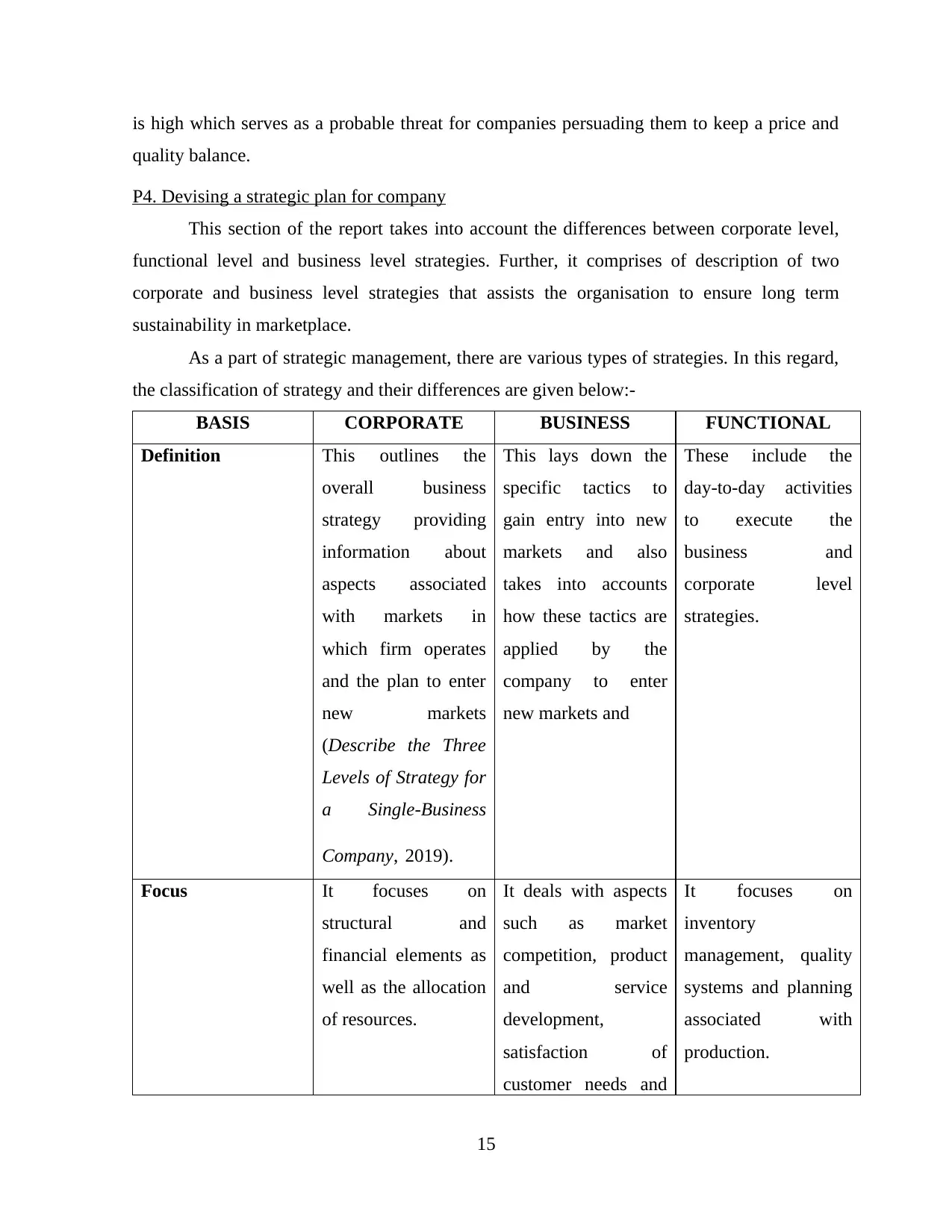
is high which serves as a probable threat for companies persuading them to keep a price and
quality balance.
P4. Devising a strategic plan for company
This section of the report takes into account the differences between corporate level,
functional level and business level strategies. Further, it comprises of description of two
corporate and business level strategies that assists the organisation to ensure long term
sustainability in marketplace.
As a part of strategic management, there are various types of strategies. In this regard,
the classification of strategy and their differences are given below:-
BASIS CORPORATE BUSINESS FUNCTIONAL
Definition This outlines the
overall business
strategy providing
information about
aspects associated
with markets in
which firm operates
and the plan to enter
new markets
(Describe the Three
Levels of Strategy for
a Single-Business
Company, 2019).
This lays down the
specific tactics to
gain entry into new
markets and also
takes into accounts
how these tactics are
applied by the
company to enter
new markets and
These include the
day-to-day activities
to execute the
business and
corporate level
strategies.
Focus It focuses on
structural and
financial elements as
well as the allocation
of resources.
It deals with aspects
such as market
competition, product
and service
development,
satisfaction of
customer needs and
It focuses on
inventory
management, quality
systems and planning
associated with
production.
15
quality balance.
P4. Devising a strategic plan for company
This section of the report takes into account the differences between corporate level,
functional level and business level strategies. Further, it comprises of description of two
corporate and business level strategies that assists the organisation to ensure long term
sustainability in marketplace.
As a part of strategic management, there are various types of strategies. In this regard,
the classification of strategy and their differences are given below:-
BASIS CORPORATE BUSINESS FUNCTIONAL
Definition This outlines the
overall business
strategy providing
information about
aspects associated
with markets in
which firm operates
and the plan to enter
new markets
(Describe the Three
Levels of Strategy for
a Single-Business
Company, 2019).
This lays down the
specific tactics to
gain entry into new
markets and also
takes into accounts
how these tactics are
applied by the
company to enter
new markets and
These include the
day-to-day activities
to execute the
business and
corporate level
strategies.
Focus It focuses on
structural and
financial elements as
well as the allocation
of resources.
It deals with aspects
such as market
competition, product
and service
development,
satisfaction of
customer needs and
It focuses on
inventory
management, quality
systems and planning
associated with
production.
15
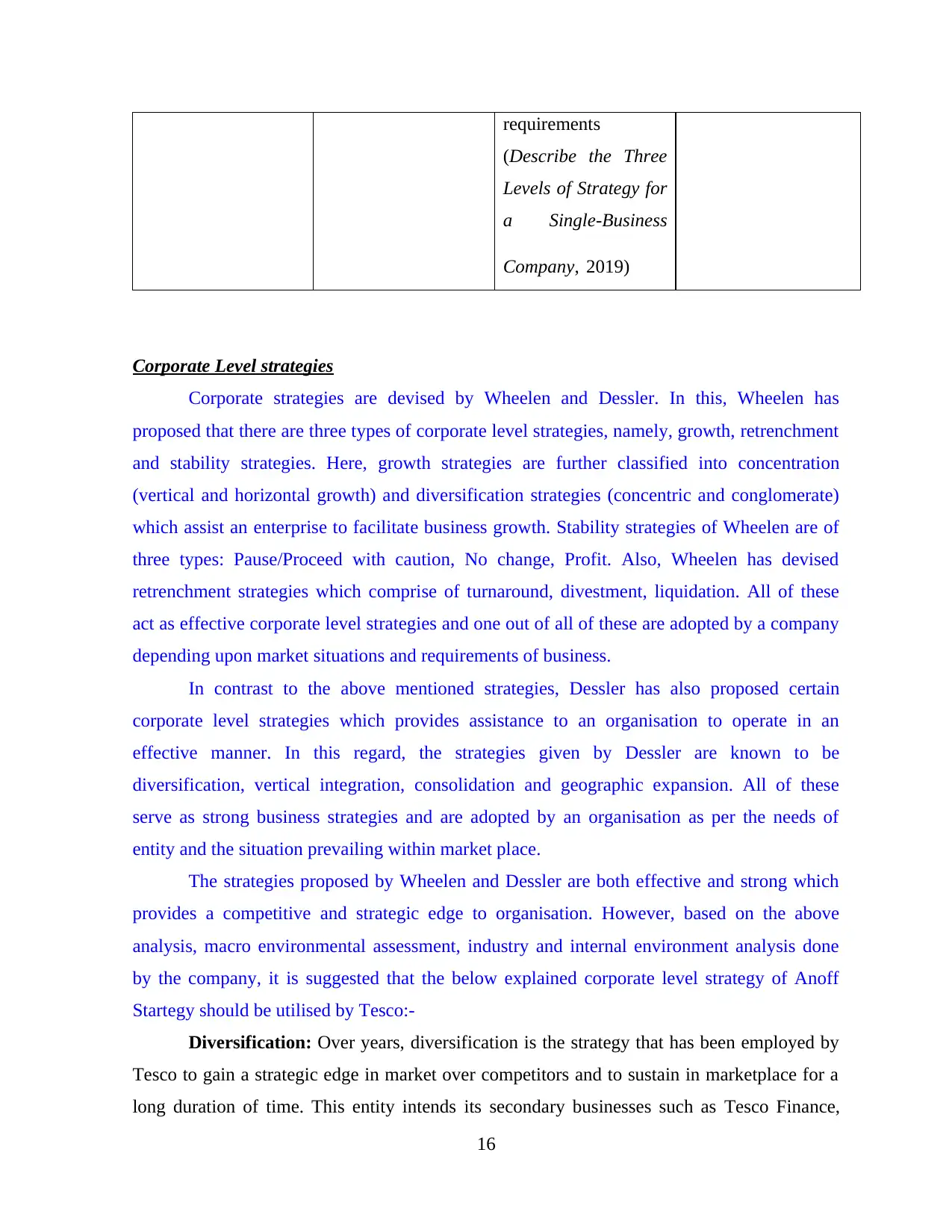
requirements
(Describe the Three
Levels of Strategy for
a Single-Business
Company, 2019)
Corporate Level strategies
Corporate strategies are devised by Wheelen and Dessler. In this, Wheelen has
proposed that there are three types of corporate level strategies, namely, growth, retrenchment
and stability strategies. Here, growth strategies are further classified into concentration
(vertical and horizontal growth) and diversification strategies (concentric and conglomerate)
which assist an enterprise to facilitate business growth. Stability strategies of Wheelen are of
three types: Pause/Proceed with caution, No change, Profit. Also, Wheelen has devised
retrenchment strategies which comprise of turnaround, divestment, liquidation. All of these
act as effective corporate level strategies and one out of all of these are adopted by a company
depending upon market situations and requirements of business.
In contrast to the above mentioned strategies, Dessler has also proposed certain
corporate level strategies which provides assistance to an organisation to operate in an
effective manner. In this regard, the strategies given by Dessler are known to be
diversification, vertical integration, consolidation and geographic expansion. All of these
serve as strong business strategies and are adopted by an organisation as per the needs of
entity and the situation prevailing within market place.
The strategies proposed by Wheelen and Dessler are both effective and strong which
provides a competitive and strategic edge to organisation. However, based on the above
analysis, macro environmental assessment, industry and internal environment analysis done
by the company, it is suggested that the below explained corporate level strategy of Anoff
Startegy should be utilised by Tesco:-
Diversification: Over years, diversification is the strategy that has been employed by
Tesco to gain a strategic edge in market over competitors and to sustain in marketplace for a
long duration of time. This entity intends its secondary businesses such as Tesco Finance,
16
(Describe the Three
Levels of Strategy for
a Single-Business
Company, 2019)
Corporate Level strategies
Corporate strategies are devised by Wheelen and Dessler. In this, Wheelen has
proposed that there are three types of corporate level strategies, namely, growth, retrenchment
and stability strategies. Here, growth strategies are further classified into concentration
(vertical and horizontal growth) and diversification strategies (concentric and conglomerate)
which assist an enterprise to facilitate business growth. Stability strategies of Wheelen are of
three types: Pause/Proceed with caution, No change, Profit. Also, Wheelen has devised
retrenchment strategies which comprise of turnaround, divestment, liquidation. All of these
act as effective corporate level strategies and one out of all of these are adopted by a company
depending upon market situations and requirements of business.
In contrast to the above mentioned strategies, Dessler has also proposed certain
corporate level strategies which provides assistance to an organisation to operate in an
effective manner. In this regard, the strategies given by Dessler are known to be
diversification, vertical integration, consolidation and geographic expansion. All of these
serve as strong business strategies and are adopted by an organisation as per the needs of
entity and the situation prevailing within market place.
The strategies proposed by Wheelen and Dessler are both effective and strong which
provides a competitive and strategic edge to organisation. However, based on the above
analysis, macro environmental assessment, industry and internal environment analysis done
by the company, it is suggested that the below explained corporate level strategy of Anoff
Startegy should be utilised by Tesco:-
Diversification: Over years, diversification is the strategy that has been employed by
Tesco to gain a strategic edge in market over competitors and to sustain in marketplace for a
long duration of time. This entity intends its secondary businesses such as Tesco Finance,
16
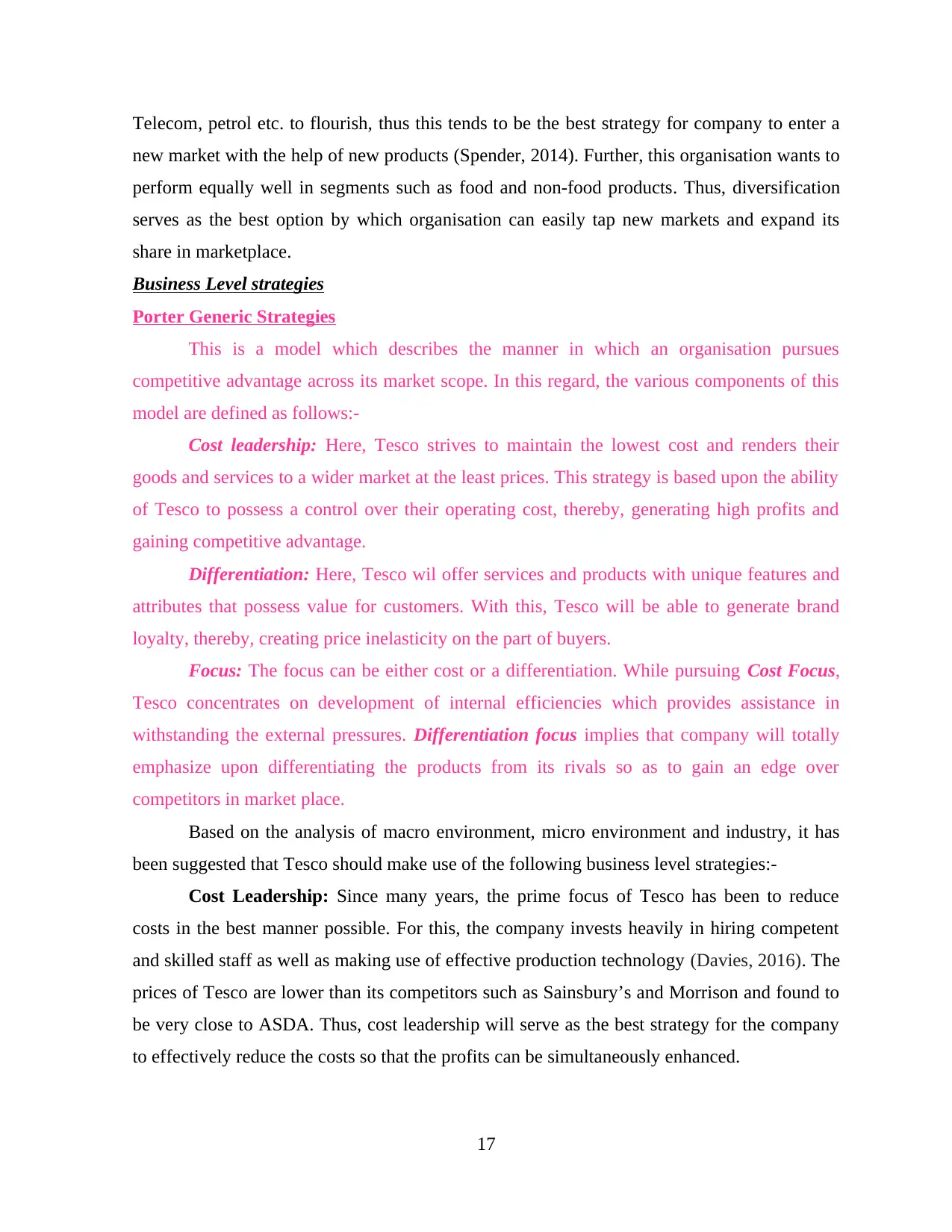
Telecom, petrol etc. to flourish, thus this tends to be the best strategy for company to enter a
new market with the help of new products (Spender, 2014). Further, this organisation wants to
perform equally well in segments such as food and non-food products. Thus, diversification
serves as the best option by which organisation can easily tap new markets and expand its
share in marketplace.
Business Level strategies
Porter Generic Strategies
This is a model which describes the manner in which an organisation pursues
competitive advantage across its market scope. In this regard, the various components of this
model are defined as follows:-
Cost leadership: Here, Tesco strives to maintain the lowest cost and renders their
goods and services to a wider market at the least prices. This strategy is based upon the ability
of Tesco to possess a control over their operating cost, thereby, generating high profits and
gaining competitive advantage.
Differentiation: Here, Tesco wil offer services and products with unique features and
attributes that possess value for customers. With this, Tesco will be able to generate brand
loyalty, thereby, creating price inelasticity on the part of buyers.
Focus: The focus can be either cost or a differentiation. While pursuing Cost Focus,
Tesco concentrates on development of internal efficiencies which provides assistance in
withstanding the external pressures. Differentiation focus implies that company will totally
emphasize upon differentiating the products from its rivals so as to gain an edge over
competitors in market place.
Based on the analysis of macro environment, micro environment and industry, it has
been suggested that Tesco should make use of the following business level strategies:-
Cost Leadership: Since many years, the prime focus of Tesco has been to reduce
costs in the best manner possible. For this, the company invests heavily in hiring competent
and skilled staff as well as making use of effective production technology (Davies, 2016). The
prices of Tesco are lower than its competitors such as Sainsbury’s and Morrison and found to
be very close to ASDA. Thus, cost leadership will serve as the best strategy for the company
to effectively reduce the costs so that the profits can be simultaneously enhanced.
17
new market with the help of new products (Spender, 2014). Further, this organisation wants to
perform equally well in segments such as food and non-food products. Thus, diversification
serves as the best option by which organisation can easily tap new markets and expand its
share in marketplace.
Business Level strategies
Porter Generic Strategies
This is a model which describes the manner in which an organisation pursues
competitive advantage across its market scope. In this regard, the various components of this
model are defined as follows:-
Cost leadership: Here, Tesco strives to maintain the lowest cost and renders their
goods and services to a wider market at the least prices. This strategy is based upon the ability
of Tesco to possess a control over their operating cost, thereby, generating high profits and
gaining competitive advantage.
Differentiation: Here, Tesco wil offer services and products with unique features and
attributes that possess value for customers. With this, Tesco will be able to generate brand
loyalty, thereby, creating price inelasticity on the part of buyers.
Focus: The focus can be either cost or a differentiation. While pursuing Cost Focus,
Tesco concentrates on development of internal efficiencies which provides assistance in
withstanding the external pressures. Differentiation focus implies that company will totally
emphasize upon differentiating the products from its rivals so as to gain an edge over
competitors in market place.
Based on the analysis of macro environment, micro environment and industry, it has
been suggested that Tesco should make use of the following business level strategies:-
Cost Leadership: Since many years, the prime focus of Tesco has been to reduce
costs in the best manner possible. For this, the company invests heavily in hiring competent
and skilled staff as well as making use of effective production technology (Davies, 2016). The
prices of Tesco are lower than its competitors such as Sainsbury’s and Morrison and found to
be very close to ASDA. Thus, cost leadership will serve as the best strategy for the company
to effectively reduce the costs so that the profits can be simultaneously enhanced.
17
Paraphrase This Document
Need a fresh take? Get an instant paraphrase of this document with our AI Paraphraser
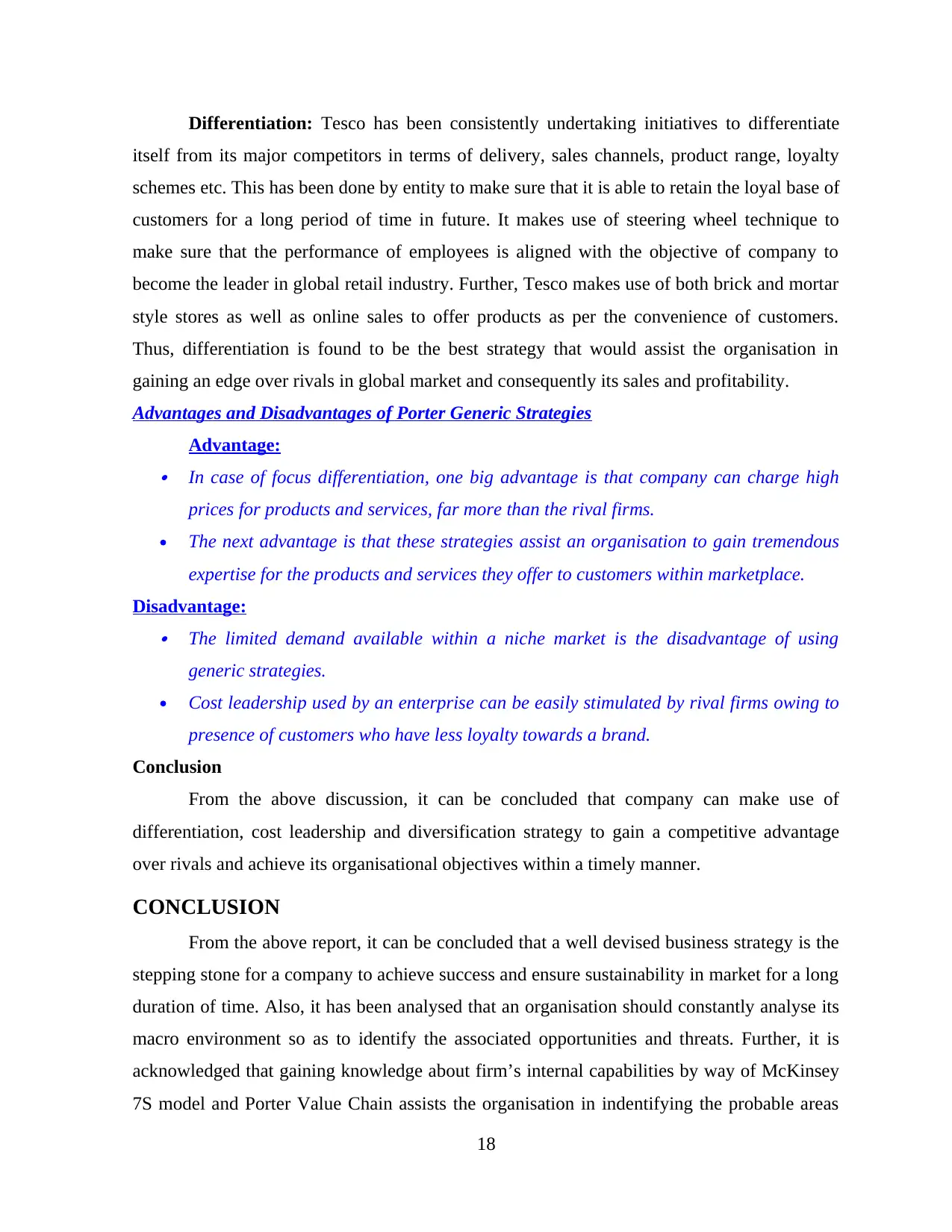
Differentiation: Tesco has been consistently undertaking initiatives to differentiate
itself from its major competitors in terms of delivery, sales channels, product range, loyalty
schemes etc. This has been done by entity to make sure that it is able to retain the loyal base of
customers for a long period of time in future. It makes use of steering wheel technique to
make sure that the performance of employees is aligned with the objective of company to
become the leader in global retail industry. Further, Tesco makes use of both brick and mortar
style stores as well as online sales to offer products as per the convenience of customers.
Thus, differentiation is found to be the best strategy that would assist the organisation in
gaining an edge over rivals in global market and consequently its sales and profitability.
Advantages and Disadvantages of Porter Generic Strategies
Advantage:
In case of focus differentiation, one big advantage is that company can charge high
prices for products and services, far more than the rival firms.
The next advantage is that these strategies assist an organisation to gain tremendous
expertise for the products and services they offer to customers within marketplace.
Disadvantage:
The limited demand available within a niche market is the disadvantage of using
generic strategies.
Cost leadership used by an enterprise can be easily stimulated by rival firms owing to
presence of customers who have less loyalty towards a brand.
Conclusion
From the above discussion, it can be concluded that company can make use of
differentiation, cost leadership and diversification strategy to gain a competitive advantage
over rivals and achieve its organisational objectives within a timely manner.
CONCLUSION
From the above report, it can be concluded that a well devised business strategy is the
stepping stone for a company to achieve success and ensure sustainability in market for a long
duration of time. Also, it has been analysed that an organisation should constantly analyse its
macro environment so as to identify the associated opportunities and threats. Further, it is
acknowledged that gaining knowledge about firm’s internal capabilities by way of McKinsey
7S model and Porter Value Chain assists the organisation in indentifying the probable areas
18
itself from its major competitors in terms of delivery, sales channels, product range, loyalty
schemes etc. This has been done by entity to make sure that it is able to retain the loyal base of
customers for a long period of time in future. It makes use of steering wheel technique to
make sure that the performance of employees is aligned with the objective of company to
become the leader in global retail industry. Further, Tesco makes use of both brick and mortar
style stores as well as online sales to offer products as per the convenience of customers.
Thus, differentiation is found to be the best strategy that would assist the organisation in
gaining an edge over rivals in global market and consequently its sales and profitability.
Advantages and Disadvantages of Porter Generic Strategies
Advantage:
In case of focus differentiation, one big advantage is that company can charge high
prices for products and services, far more than the rival firms.
The next advantage is that these strategies assist an organisation to gain tremendous
expertise for the products and services they offer to customers within marketplace.
Disadvantage:
The limited demand available within a niche market is the disadvantage of using
generic strategies.
Cost leadership used by an enterprise can be easily stimulated by rival firms owing to
presence of customers who have less loyalty towards a brand.
Conclusion
From the above discussion, it can be concluded that company can make use of
differentiation, cost leadership and diversification strategy to gain a competitive advantage
over rivals and achieve its organisational objectives within a timely manner.
CONCLUSION
From the above report, it can be concluded that a well devised business strategy is the
stepping stone for a company to achieve success and ensure sustainability in market for a long
duration of time. Also, it has been analysed that an organisation should constantly analyse its
macro environment so as to identify the associated opportunities and threats. Further, it is
acknowledged that gaining knowledge about firm’s internal capabilities by way of McKinsey
7S model and Porter Value Chain assists the organisation in indentifying the probable areas
18
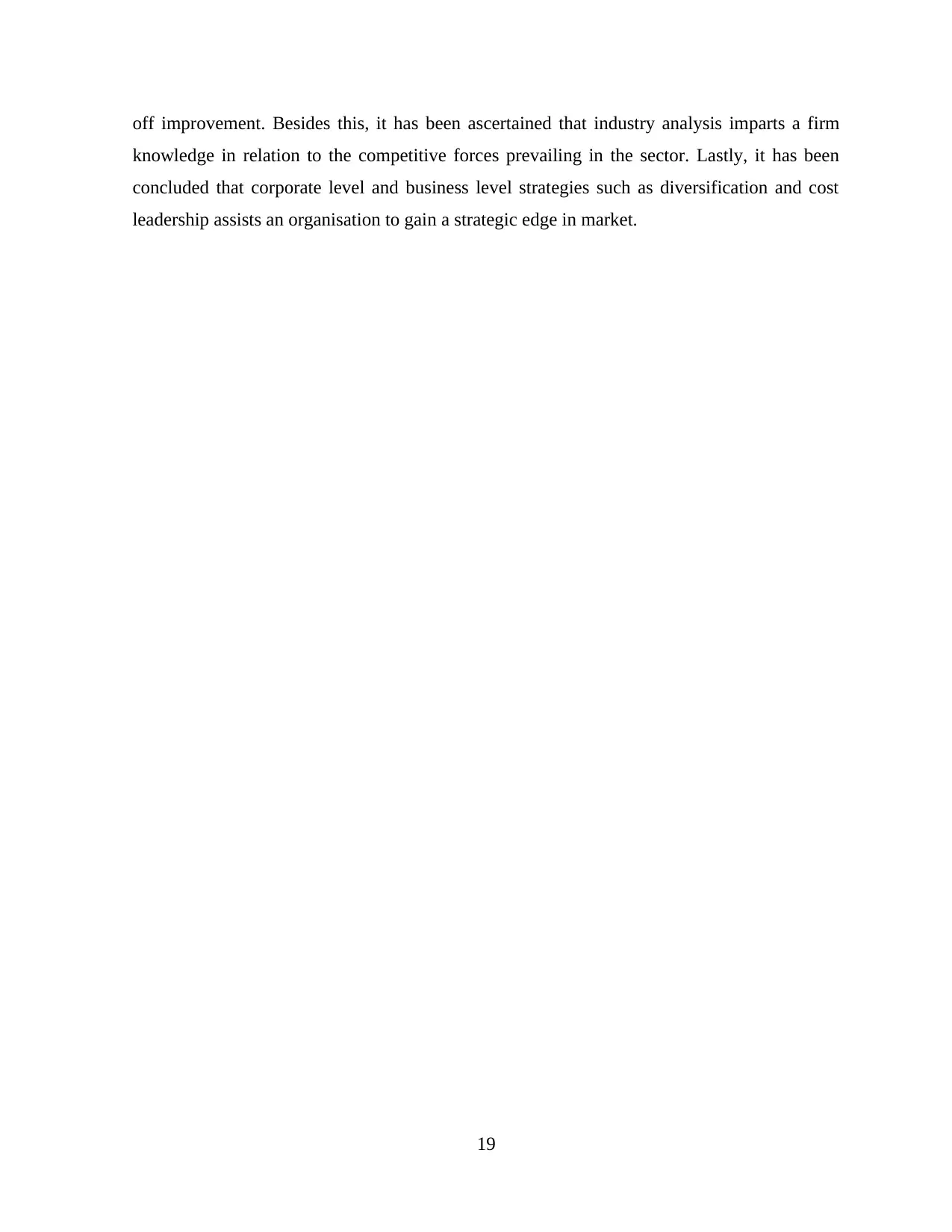
off improvement. Besides this, it has been ascertained that industry analysis imparts a firm
knowledge in relation to the competitive forces prevailing in the sector. Lastly, it has been
concluded that corporate level and business level strategies such as diversification and cost
leadership assists an organisation to gain a strategic edge in market.
19
knowledge in relation to the competitive forces prevailing in the sector. Lastly, it has been
concluded that corporate level and business level strategies such as diversification and cost
leadership assists an organisation to gain a strategic edge in market.
19
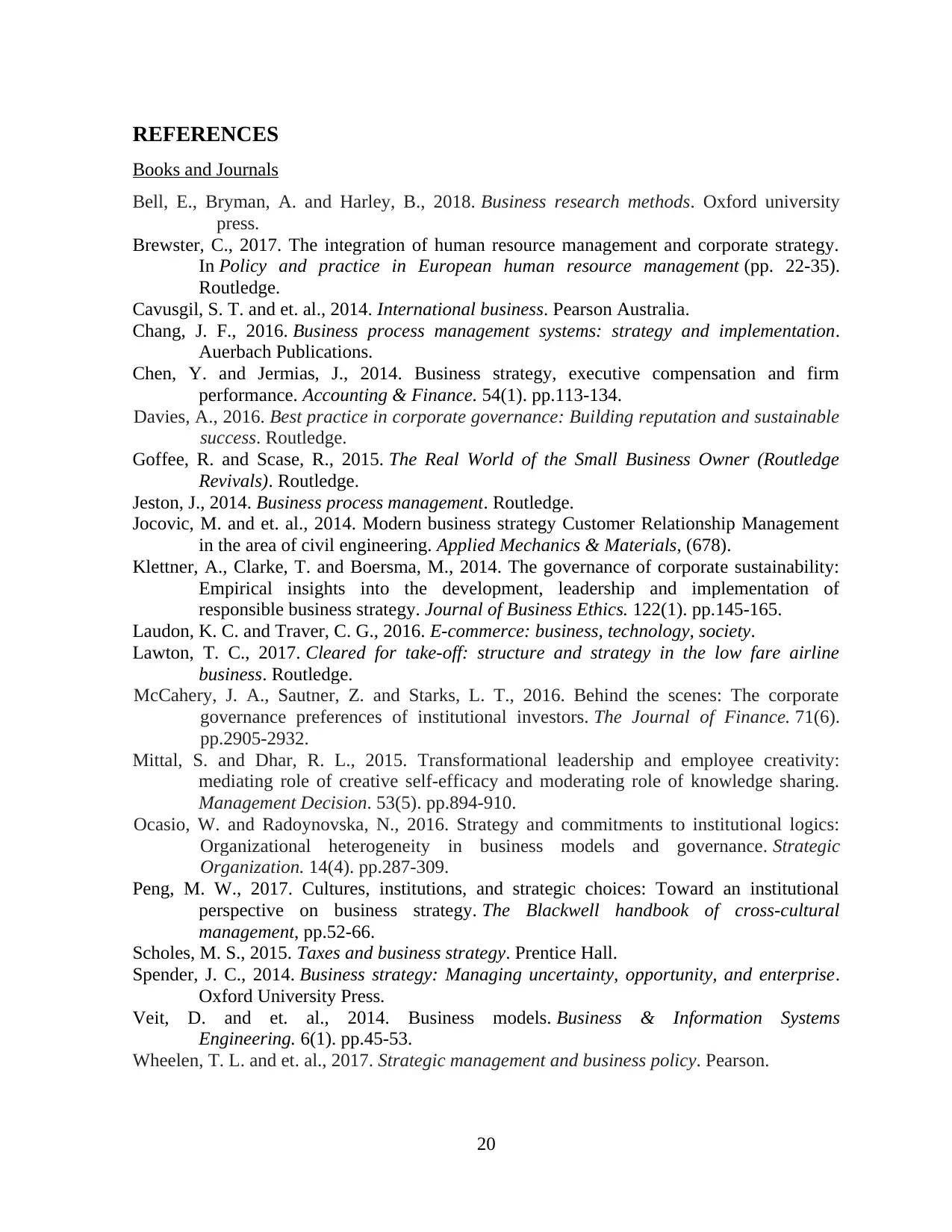
REFERENCES
Books and Journals
Bell, E., Bryman, A. and Harley, B., 2018. Business research methods. Oxford university
press.
Brewster, C., 2017. The integration of human resource management and corporate strategy.
In Policy and practice in European human resource management (pp. 22-35).
Routledge.
Cavusgil, S. T. and et. al., 2014. International business. Pearson Australia.
Chang, J. F., 2016. Business process management systems: strategy and implementation.
Auerbach Publications.
Chen, Y. and Jermias, J., 2014. Business strategy, executive compensation and firm
performance. Accounting & Finance. 54(1). pp.113-134.
Davies, A., 2016. Best practice in corporate governance: Building reputation and sustainable
success. Routledge.
Goffee, R. and Scase, R., 2015. The Real World of the Small Business Owner (Routledge
Revivals). Routledge.
Jeston, J., 2014. Business process management. Routledge.
Jocovic, M. and et. al., 2014. Modern business strategy Customer Relationship Management
in the area of civil engineering. Applied Mechanics & Materials, (678).
Klettner, A., Clarke, T. and Boersma, M., 2014. The governance of corporate sustainability:
Empirical insights into the development, leadership and implementation of
responsible business strategy. Journal of Business Ethics. 122(1). pp.145-165.
Laudon, K. C. and Traver, C. G., 2016. E-commerce: business, technology, society.
Lawton, T. C., 2017. Cleared for take-off: structure and strategy in the low fare airline
business. Routledge.
McCahery, J. A., Sautner, Z. and Starks, L. T., 2016. Behind the scenes: The corporate
governance preferences of institutional investors. The Journal of Finance. 71(6).
pp.2905-2932.
Mittal, S. and Dhar, R. L., 2015. Transformational leadership and employee creativity:
mediating role of creative self-efficacy and moderating role of knowledge sharing.
Management Decision. 53(5). pp.894-910.
Ocasio, W. and Radoynovska, N., 2016. Strategy and commitments to institutional logics:
Organizational heterogeneity in business models and governance. Strategic
Organization. 14(4). pp.287-309.
Peng, M. W., 2017. Cultures, institutions, and strategic choices: Toward an institutional
perspective on business strategy. The Blackwell handbook of cross‐cultural
management, pp.52-66.
Scholes, M. S., 2015. Taxes and business strategy. Prentice Hall.
Spender, J. C., 2014. Business strategy: Managing uncertainty, opportunity, and enterprise.
Oxford University Press.
Veit, D. and et. al., 2014. Business models. Business & Information Systems
Engineering. 6(1). pp.45-53.
Wheelen, T. L. and et. al., 2017. Strategic management and business policy. Pearson.
20
Books and Journals
Bell, E., Bryman, A. and Harley, B., 2018. Business research methods. Oxford university
press.
Brewster, C., 2017. The integration of human resource management and corporate strategy.
In Policy and practice in European human resource management (pp. 22-35).
Routledge.
Cavusgil, S. T. and et. al., 2014. International business. Pearson Australia.
Chang, J. F., 2016. Business process management systems: strategy and implementation.
Auerbach Publications.
Chen, Y. and Jermias, J., 2014. Business strategy, executive compensation and firm
performance. Accounting & Finance. 54(1). pp.113-134.
Davies, A., 2016. Best practice in corporate governance: Building reputation and sustainable
success. Routledge.
Goffee, R. and Scase, R., 2015. The Real World of the Small Business Owner (Routledge
Revivals). Routledge.
Jeston, J., 2014. Business process management. Routledge.
Jocovic, M. and et. al., 2014. Modern business strategy Customer Relationship Management
in the area of civil engineering. Applied Mechanics & Materials, (678).
Klettner, A., Clarke, T. and Boersma, M., 2014. The governance of corporate sustainability:
Empirical insights into the development, leadership and implementation of
responsible business strategy. Journal of Business Ethics. 122(1). pp.145-165.
Laudon, K. C. and Traver, C. G., 2016. E-commerce: business, technology, society.
Lawton, T. C., 2017. Cleared for take-off: structure and strategy in the low fare airline
business. Routledge.
McCahery, J. A., Sautner, Z. and Starks, L. T., 2016. Behind the scenes: The corporate
governance preferences of institutional investors. The Journal of Finance. 71(6).
pp.2905-2932.
Mittal, S. and Dhar, R. L., 2015. Transformational leadership and employee creativity:
mediating role of creative self-efficacy and moderating role of knowledge sharing.
Management Decision. 53(5). pp.894-910.
Ocasio, W. and Radoynovska, N., 2016. Strategy and commitments to institutional logics:
Organizational heterogeneity in business models and governance. Strategic
Organization. 14(4). pp.287-309.
Peng, M. W., 2017. Cultures, institutions, and strategic choices: Toward an institutional
perspective on business strategy. The Blackwell handbook of cross‐cultural
management, pp.52-66.
Scholes, M. S., 2015. Taxes and business strategy. Prentice Hall.
Spender, J. C., 2014. Business strategy: Managing uncertainty, opportunity, and enterprise.
Oxford University Press.
Veit, D. and et. al., 2014. Business models. Business & Information Systems
Engineering. 6(1). pp.45-53.
Wheelen, T. L. and et. al., 2017. Strategic management and business policy. Pearson.
20
1 out of 22
Related Documents
Your All-in-One AI-Powered Toolkit for Academic Success.
+13062052269
info@desklib.com
Available 24*7 on WhatsApp / Email
![[object Object]](/_next/static/media/star-bottom.7253800d.svg)
Unlock your academic potential
© 2024 | Zucol Services PVT LTD | All rights reserved.



